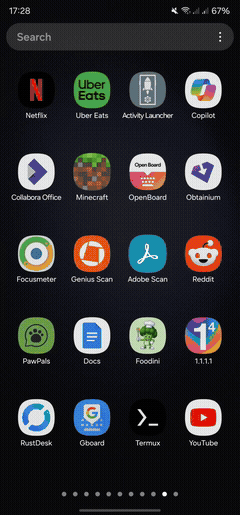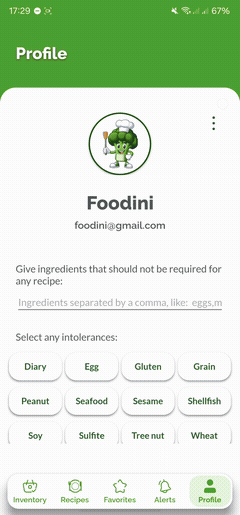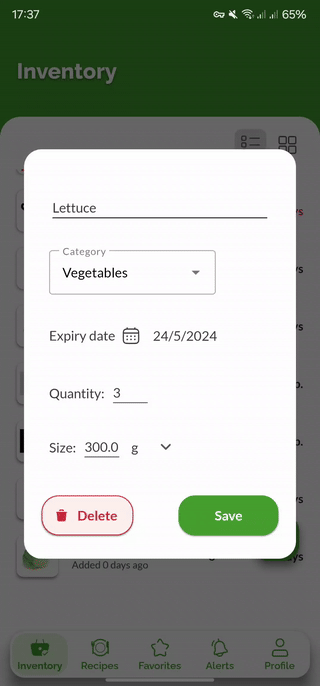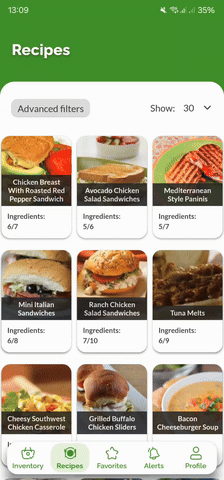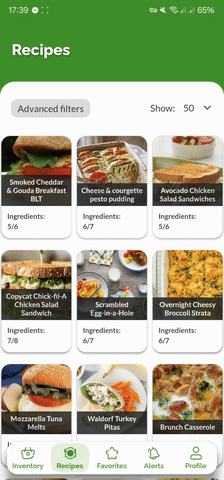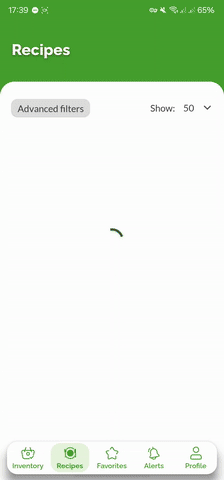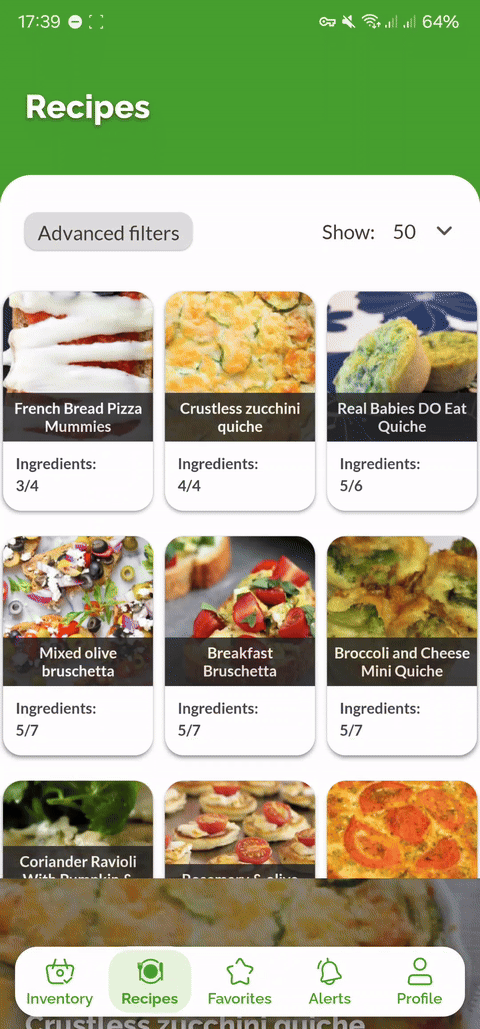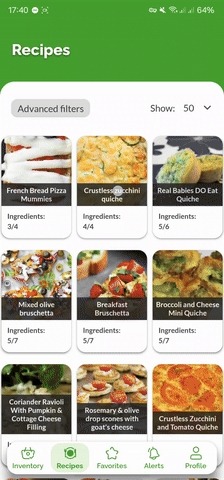PRE2023 3 Group6: Difference between revisions
Tag: 2017 source edit |
Tag: 2017 source edit |
||
| Line 552: | Line 552: | ||
[[File:Edit ingredient.gif|none|thumb|Edit Ingredient|200px]] | [[File:Edit ingredient.gif|none|thumb|Edit Ingredient|200px]] | ||
[[File:Change view.gif|none|thumb|Change View|200px]] | [[File:Change view.gif|none|thumb|Change View|200px]] | ||
[[File:Batch delete.gif|none|thumb|Batch delete|200px]] | |||
</div> | </div> | ||
==== Actions ==== | ==== Actions ==== | ||
Revision as of 18:31, 6 April 2024
Foodini
Group members
| Name | Student number | Study | |
| Sem van Birgelen | 1813862 | Industrial Design | s.v.birgelen@student.tue.nl |
| Manka Huszár | 1581368 | Computer Science and Engineering | m.huszar@student.tue.nl |
| Aydan Bakhshi | 1671189 | Applied Physics | a.bakhshi@student.tue.nl |
| Yi Hang Cheung | 1014298 | Computer Science and Engineering | y.h.cheung@student.tue.nl |
| Bohao Ye | 1809903 | Computer Science and Engineering | b.ye1@student.tue.nl |
| Vlad Chibulcutean | 1780980 | Computer Science and Engineering | v.chibulcutean@student.tue.nl |
Introduction
Problem Statement
Food waste can be defined as "Food appropriate for human consumption being discarded, whether after it is left to spoil or kept beyond its expiry date."[1] Food waste is recognized as a serious threat to food security, the economy, and the environment. 37% percent of food is wasted in households in the US[2], and in the EU, households generate more than half of the total food waste (54%)[3]. The causes of food waste could be food expiration, overshopping, and often these relate to poor meal planning and insufficient food management skills. Solving the problem of food waste will help combat undernourishment and meet the increasing food demand across the world.
Objectives
- Create an app that suggests recipes based on the contents of the user's fridge;
- Investigate how technology can be used to combat food waste. More specifically:
- How much food is wasted in households;
- What are the main reasons for food waste;
- How to prevent food waste;
- What would be a convenient way for users to keep oversight of fridge contents;
- What incentives could be used to motivate consumers to prevent food waste
- How AI can assist in preventing food waste
- Check other recipe suggesting apps / websites, what features would be useful to add / what's missing.
Users & Requirements
Users
Adults in households, possibly restaurants and grocery stores.
User requirements
- Easy to use platform to save food
- Recipe suggestions
- Reminders about expiry dates
App requirements
Basic features:
- Firebase account login
- Inventory:
- Shopping list
- Edit list
- Expiry date (barcode)
- Recipe suggestions based on:
- Inventory
- Expiry dates
- [Optional] Cuisine (Italian, Asian, Mexican, etc.)
- [Optional] Preparation time
Extra features:
- Look at local supermarkets for ingredients about to expire and, if possible, include them in recipes against discounted price (Analogous to "To Good To Go");
- Scan the barcode of the product to add it to the list automatically.
Design process
Literature study
Definitions of Food Loss & Food Waste
In general, food loss and waste collectively (FLW), as defined by FAO High Level Panel of Experts[4], “refers to a decrease, at all stages of the food chain from harvest to consumption, in mass of food that was originally intended for human consumption, regardless of the cause”.
Food loss refers to “edible food mass that is discarded OR lost along the journey from production, post-harvest, storage, transport, and processing stages[5].” Another definition of food loss is “A decrease, at all stages of the food supply chain (FSC) prior to the consumer level, in mass of food that was originally intended for human consumption, regardless of the cause[1].” Thus, the definition of food loss excludes the last stage of the food supply chain, namely the consumption stage.
On the other hand, food waste, as suggested by Ishagulyyev et al.[1], is “food appropriate for human consumption being discarded, whether after it is left to spoil of kept beyond its expiry date”.
According to the FUSION'S framework food waste is: “Food waste is any food, and inedible parts of food, removed from the food supply chain to be recovered or disposed (including composted, crops ploughed in/not harvested, anaerobic digestion, bio-energy production, co-generation, incineration, disposal to sewer, landfill or discarded to sea)[6].” However, in this research, the term “food waste” will refer only to the losses at the consumption stage of the FSC.
Additionally, it is important to distinguish avoidable FLW from unavoidable FLW[1]. Unavoidable FLW refers to the types of food that cannot be consumed by humans, for example, meat bones and watermelon skins, while avoidable FLW encompasses “the types of foods that could have been used or eaten at some point of FSC but neither used nor eaten”. Naturally, the latter definition will be considered.
Statistics
Despite abundant global food resources, challenges in physical and economic access, food utilization, and political stability hinder worldwide food security. As a result, approximately 815 million people, around 11% of the world's population, suffered from chronic undernourishment in 2016. Predominantly, these individuals were from lower-middle-income countries, with developed nations having only 11 million undernourished people. In the mid-2010s, Africa had the highest prevalence of malnutrition, while Asia had the largest number of malnourished individuals.
This issue leads to an estimated 3.1 million child deaths annually. In 2017, 150 million young children globally experienced growth stunting, while 50 million suffered from muscle wasting. Similarly, deficiencies of micronutrients like iron, vitamin A, and iodine have significant health effects, causing poor pregnancy outcomes, impaired development, night blindness, and weakened disease resistance, among others. Iodine deficiency, specifically, impairs cognitive development and affects close to 40 million babies worldwide[1].
The more alarming aspect of this issue is that it persists while one-third of all food produced globally is lost or wasted. This waste amounts to approximately 1.3 billion tons of food, costing the global economy nearly one trillion dollars yearly. Per capita food loss in Europe and North America is around 300 kilograms a year, while per capita food waste is approximately 100 kilograms per year. To put these numbers into perspective, annual food waste at the consumer level in developed countries—222 tons—is nearly as high as the total net food production in Sub-Saharan Africa, at 230 tons[2].
Beyond the issue of undernourishment, the impact of food waste can be assessed in terms of environmental, economic, and social aspects. Environmentally, food losses signify a squandering of resources used in production, encompassing land, water, energy, and other inputs[2]. The global carbon footprint of wasted food is estimated to be nearly 3.3 gigatons of CO2, ranking third globally in emissions after the United States and China. This amount of CO2 surpasses twice the total greenhouse gas emissions from all US road transportation, equating to around 500 kg of CO2 per capita globally. Cereals contribute the most to this waste, followed by meat and fresh produce.
In terms of water wastage, the numbers are notably significant, with a staggering 92% of humanity's total water footprint attributed to the consumption of agricultural products. Specifically, the average water footprint of food waste per capita annually is 38 cubic meters[7], equivalent to the annual flow of Russia’s Volga River when added up[4]. Land occupation and degradation are also significant factors. Global food wastage has occupied as much as 1.4 billion hectares of farming land, approximately 28% of the world’s total agricultural land area. When compared to the surface areas of the world’s largest countries, this is second only to that of the world’s largest country, the Russian Federation. Meat and milk contribute to 78% of this total area, but only 11% of overall food wastage. Biodiversity impacts, including deforestation, Red-listed species, and marine trophic levels, are of great importance. In developed nations, agriculture causes 44% of species threats, while in developing nations, this number rises to 72%. Globally, agriculture is responsible for 66% of threats to species, with mammals, amphibians, and birds being the most affected animal families[7].
Economically, food losses negatively impact the incomes of both farmers and consumers[2]. This impact has been measured at nearly 1 trillion dollars globally, with Indian and Southeast Asia contributing the most to these costs. Economic costs surpass environmental ones, amounting to approximately $700 billion, and social costs, totaling around $900 billion. In Italy, economic costs due to food waste in the last phase of the supply chain add up to as much as $12 billion annually. In the UK, food waste within the out-of-home industry accounts for more than £682 million annually, covering food procurement, labor and service costs, utilities, and waste management costs. Additionally, the economic cost of food waste for households in the UK is approximately £420 per year, €454 per year in Italy, and in the US, households discard 211 kg of food per year, costing at least US$587 annually for a family of four[4].
Looking at social costs, their primary implications revolve around increased poverty, food insecurity, unequal distribution of resources, strain on social services, public health issues, and negative impact on mental health, as described in the above paragraphs. Food being lost or wasted worsens each of these factors, amplifying an immense variety of social issues[4].
Food Waste at Consumer Level
There are five main stages of FSC that can be identified: production, handling and storage, processing, distribution and market, and consumption[1]. Food loss can be identified in the first three stages, while food waste occurs in the last two. In this study, only the last stage of FSC, namely the consumption stage, will be considered. This choice can be justified by the fact that a large portion of food waste that can be avoided occurs at the consumption stage. For instance, in Europe, this amounts to 42% of all the produced food, or 88 million tonnes, wasted per year; two-thirds of this amount belongs to avoidable or possibly avoidable food waste. In the United States, 31% of all the food available for consumption is lost at the retail and consumer levels[4]. Thus, the issue of food waste in the consumption stage of the FSC is particularly common in developed countries[1][4]. The most common reasons for food waste at this stage are discussed below.
One of the deciding factors is household size. Smaller households tend to generate more food waste due to over-provisioning or cooking more than can be consumed[1]. Also, households with children generate more food waste due to children’s unpredictable behavior and varying food preferences[1][4]. However, in general, large households tend to generate less food waste than single-person households. Moreover, single-person households generate the most food waste per capita[1].
Another key factor is the household income. Households with higher incomes are prone to generating more food waste as food costs are low relative to other expenditures. This also accounts for the fact that more food is wasted at the consumption stage in the developed countries than in the developing countries. For comparison, U.S. citizens spent 6.1% of their income on food, while in Pakistan and Cameroon, the proportion was 47.7% and 45.9%, respectively[1].
As for socio-demographic factors, such as age or gender, there is no clear correlation with the amount of food waste generated in households. On the other hand, culture has a significant impact on food waste; countries that emphasize the quality of food over quantity tend to generate less food waste. Various cultural events, such as weddings, parties, or religious gatherings also produce a significant amount of food waste[1].
Other reasons for food waste at the consumer level can be attributed to various household practices, such as meal planning, grocery shopping, storing, cooking, eating, and managing leftover food[7]. These are explored in detail below.
Overprovisioning is a prevalent problem when it comes to food waste. While most consumers claim to buy adequate amounts of food, according to [7], people tend to buy more produce than necessary. The reasons for overprovisioning can be attributed to differences in taste among household members, stockpiling food for unexpected circumstances, limited amount of time that can be dedicated to cooking, bulk purchasing, and large packaging size. While it is commonly thought that bulk purchasing results in more waste, the research indicates that the opposite is true, that is, households that buy discounted food or consider low prices generate less waste. Therefore, households that can afford to spend more money on food generate more waste, which agrees with the argument about household income[7].
Another common reason for food waste can be attributed to improper storage of certain food products and poor organizing practices[1][7]. For instance, a wrong temperature setting in the fridge, a common occurrence in households, can affect the longevity of the stored food[7].
Poor cooking and leftover management practices can also result in food waste. The inability to assess the freshness and safety of food leftovers often results in their disposal. Also, as mentioned above, households with children experience difficulties in planning and cooking meals, which also affects the amount of food waste. Lastly, an improper portion size estimate also affects the amount of food waste[7].
Evaluating the freshness and edibility of food has a direct correlation with the amount of food waste produced by a household. It has been shown that people who use their own senses to assess edibility discard less food than those who discard food after it has been kept in the fridge for several days. It has been pointed out that people experience a conflict between reducing food waste and avoiding food-borne illnesses. Safety concerns are a primary reason for food waste[7].
A common reason leading to food waste is misinterpretation of various food labels; people tend to rely on “use by date” and discard expired food items even if they are still safe to consume[7].
Another important factor that determines the amount of food waste produced is the individual’s knowledge, perceptions, and attitudes toward food waste. More specifically, the knowledge about the severity of food waste and attitude toward the problem can influence the behavior of the individual as well as their intentions. While the behaviors might not be consistent with the attitudes and intentions (also known as the attitude-behavior gap), the research indicates that in most cases, there is a positive correlation between attitude and actual behavior regarding food waste reduction. Moreover, attitudes and perceptions can also influence the problem of food waste indirectly. For example, various food-related routines, such as planning and shopping, are also influenced by attitudes[1].
Finally, it is instructive to look at a study conducted by Hermanussen et al.[8] that revealed the most common reasons for food waste in German households. According to the results of the questionnaire, the most common driving force behind food waste is the lack of time to cook (or process) food. Another common reason is that respondents cook more food than they can consume, and the leftovers are disposed of. Finally, the third most common reason is, as mentioned by [7], the large packaging size.
Theory of Planned Behavior
As mentioned before, a significant factor in food waste reduction is the individual’s attitude, intentions and behaviors. Therefore, studying behavior change can provide more insight into the underlying reasons for food waste and, consequently, aid in designing interventions that will cause a positive shift in the behavior and habits among consumers.
One of the theories that can be applied to the problem of food waste is the theory of planned behavior[9][10]. The theory of planned behavior predicts an individual’s intention to engage in a behavior at a specific time and place. The theory aims to explain the behaviors over which people can exert self-control.
According to the theory, three kinds of considerations guide the formation of intentions: behavioral beliefs and attitudes, normative beliefs and subjective norm, control beliefs and perceived behavioral control[9].
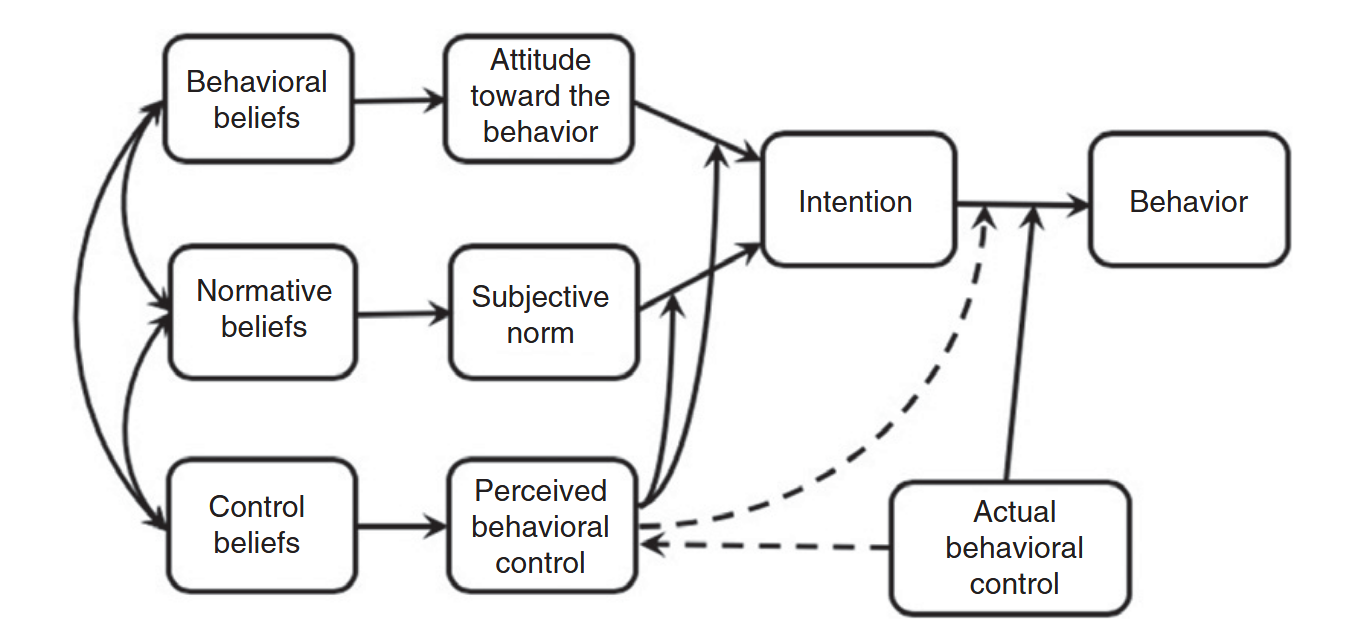
A behavioral belief is a perceived likelihood that engaging in a behavior will result in a certain outcome or involve a certain experience. For example, if someone believes that studying hard will result in good grades, they are more likely to have a positive attitude toward studying. Behavioral beliefs as a whole result in a positive or negative attitude toward a behavior.
As for normative beliefs, two types can be distinguished, namely injunctive and descriptive. An injunctive normative belief is the probability or expectation that an important figure(s), such as friends, family members, or coworkers, approve of the behavior in question. A descriptive normative belief, on the other hand, refers to expectations that important figures themselves would engage in the desired behavior. Both types of belief contribute to the perceived social pressure to engage in a behavior or subjective norm.
Finally, control beliefs refer to the presence of factors that can aid or hinder performing the desired behavior, such as required skills and abilities, amount of available time, money and other resources, cooperation by others, etc. Altogether, control beliefs constitute the perceived behavioral control. Moreover, two subfactors of control can be identified, namely capacity and autonomy. Capacity refers to the perceived ability to perform the behavior (as dictated by perceived available skills and resources), while autonomy refers to the extent to which a person believes that the decision to engage in a behavior is completely up to them.
A study by Srivastava et al.[11] has shown that the attitude, subjective norm and perceived behavioral control significantly impact the intention to reduce food waste. Moreover, it was concluded that personal attitudes and perceived behavioral control directly hits food loss behavior. People’s intentions to do something are strengthened once they have a favorable attitude toward the behavior, consider that prominent people want them to act in a confident approach, and assume that they have enough power to engage in the desired behavior. Almost all of these structures reflect a person’s personal beliefs.
Another study conducted by Ali et al.[12] concluded that attitude and social norms influence consumer intentions to purchase certain green product productions, purchase, and consumption. In particular, social media among other electronic sources is the most widely used (surfed) media, strongly reshaping and changing consumer behaviors. Thus, consumers are more aware of environmental sustainability, green consumption, and green production.
The theory of planned behavior can be used to achieve behavior change in three different ways[9]. First, this can be done by influencing behavioral or normative beliefs, which results in a more favorable attitude toward the behavior or a more supportive subjective norm, and increased motivation to engage in a behavior. Next, increasing perceived behavioral control can amplify the effects of attitude and/or subjective norm on intention to perform the behavior. Finally, behavior change can be achieved by changing the relative importance of attitude and subjective norm as determinants of intention. In other words, if the behavior was mainly influenced by attitudinal control, an intervention targeted at normative beliefs may raise awareness of social norms and increase their influence on intention.
Thus, the theory of planned behavior provides a framework for shifting attitudes and behaviors toward the desired ones. Several techniques from the theory can be applied to the design of an intervention in the form of a mobile application. In this case, the behavior change can be achieved mainly through raising perceived behavioral control over the problem of food waste. Also, the app can be used to shift the beliefs and attitudes toward food waste in general. Several specific examples are presented below.
For instance, various recipe suggestions based on the products in the user’s fridge can motivate the user to waste less produce and not to buy excessively. Also, providing information about expiry dates and tips on food storage can increase the user’s perceived control over food waste and thus help them increase the lifespan of the goods in their inventory. Sending notifications when the product is about to expire can motivate users to engage in the desired behavior more (consuming or cooking with items close to expiry date and thus reducing food waste).
More generally, informing users about food waste via a dedicated info tab can shift their beliefs and attitudes and thus motivate them to produce less food waste. Lastly, a simple and intuitive app design can motivate people to engage in the desired behavior more, namely organizing your fridge and pantry, and cooking suggested recipes.
Ways to Combat Food Waste
The issue of food waste can be combated in various ways. For instance, planning strategies, such as making a shopping list, meal-planning in advance, checking the inventory before shopping can reduce the amount of food waste. For example, it was shown by [7] that using a shopping list reduced the amount of waste by approximately 20%. Also, establishing communication between household members can help avoid buying unnecessary products[7].
Additionally, storing strategies, such as freezing food, can help extend the shelf life of a product and, thus, prevent food waste. Also, it is speculated that informing the consumers about how to store food may affect the attitude toward food waste and, consequently, induce changes in food waste behavior[7].
Moreover, an individual’s knowledge and attitudes toward food waste also affects the amount of food waste produced. Consumers that are more aware about food waste and understand its consequences are more determined to reduce the amount of food waste they produce. Thus, it is important to conduct campaigns and expose people to the problem of food waste more[1].
In terms of technological developments, current literature highlights various that hold promise in mitigating food waste, with applications and websites standing out as particularly versatile tools. These platforms offer a range of functionalities, from meal planning and recipe recommendation to food tracking, catering to different needs across the food supply chain. For example, meal planning apps optimize food usage by suggesting recipes based on available ingredients, lowering waste by ensuring everything gets used efficiently. Additionally, they streamline meal organization, leading to more strategic grocery shopping and less over-purchasing. Similarly, food tracking apps empower users to monitor pantry and fridge contents, nudging timely consumption of perishable items before they spoil. Lastly, initiatives like food sharing apps promote the redistribution of extra food, preventing waste and increasing food security efforts by connecting excess food with those in need.
Another helpful development has been the "smartification" of everyday objects as well as the immense growth of the Internet of Things. Smart refrigerators, which are equipped with sensors and connectivity features, can now constantly monitor internal conditions and track expiration dates, ensuring that food stays fresh for longer periods and alerting users before items spoil. Moreover, the integration of IoT technology into food inventory management systems has revolutionized the way food stocks are tracked and utilized. Real-time monitoring of inventory levels enables highly accurate demand forecasting and prevents over-purchasing. Smart food storage containers offer additional layers of protection against spoilage, by providing users with insights into the freshness of stored items and offering suggestions on how to use them efficiently. Furthermore, IoT-integrated food delivery services optimize logistics operations, minimize transit times, and ensure that perishable goods arrive at their destinations in optimal condition. As for the application of IoT technology in agriculture, this has enhanced productivity and reduced losses throughout the food supply chain. Sensors deployed in fields collect valuable data on soil conditions, moisture levels, and crop health, enabling farmers to implement precision agriculture practices that maximize yields while minimizing waste.
The last notable technological development that we mention here, and that is likely to create significant impacts, is artificial intelligence. AI holds immense potential in mitigating food waste through its capabilities in data analysis, prediction, and optimization. Through machine learning algorithms, AI systems can analyze vast datasets related to food production, distribution, and consumption to identify patterns and trends associated with waste. This insight should enable stakeholders to make more informed decisions and implement targeted interventions to minimize waste at various stages of the food supply chain. For instance, AI-powered demand forecasting models can accurately predict consumer preferences and market demand, allowing retailers and food manufacturers to optimize production schedules and inventory levels, thereby reducing the likelihood of overproduction and excess inventory. Additionally, AI-driven optimization algorithms can optimize logistics operations, route planning, and inventory management, ensuring efficient distribution of perishable goods and minimizing the risk of spoilage during transportation. Moreover, AI can facilitate personalized meal planning and recipe recommendations based on individual preferences and dietary restrictions, encouraging consumers to make more efficient use of ingredients and leftovers, ultimately reducing household food waste.
In summary, a multitude of methods exist for mitigating food waste, with many making use of recent technological advancements, like our initiative. It's crucial to thoroughly research these methods before implementing any new strategies to reduce food waste, as this maximizes the likelihood of success. By carefully considering and utilizing the available tools and technologies, the issue of food waste can be addressed effectively, and a more sustainable food system can be worked towards.
State-of-the-art Apps
Prior to creating a mobile application, it is instructive to look at the state-of-the-art apps and investigate their functionality. For this purpose, ten apps were selected from Google Play based on the number of downloads and user ratings. The selected apps can be divided into two main categories: apps that suggest recipes and help with meal planning and apps that keep track of expiry dates. The summaries are provided below.
Recipes & Meal Planning Apps
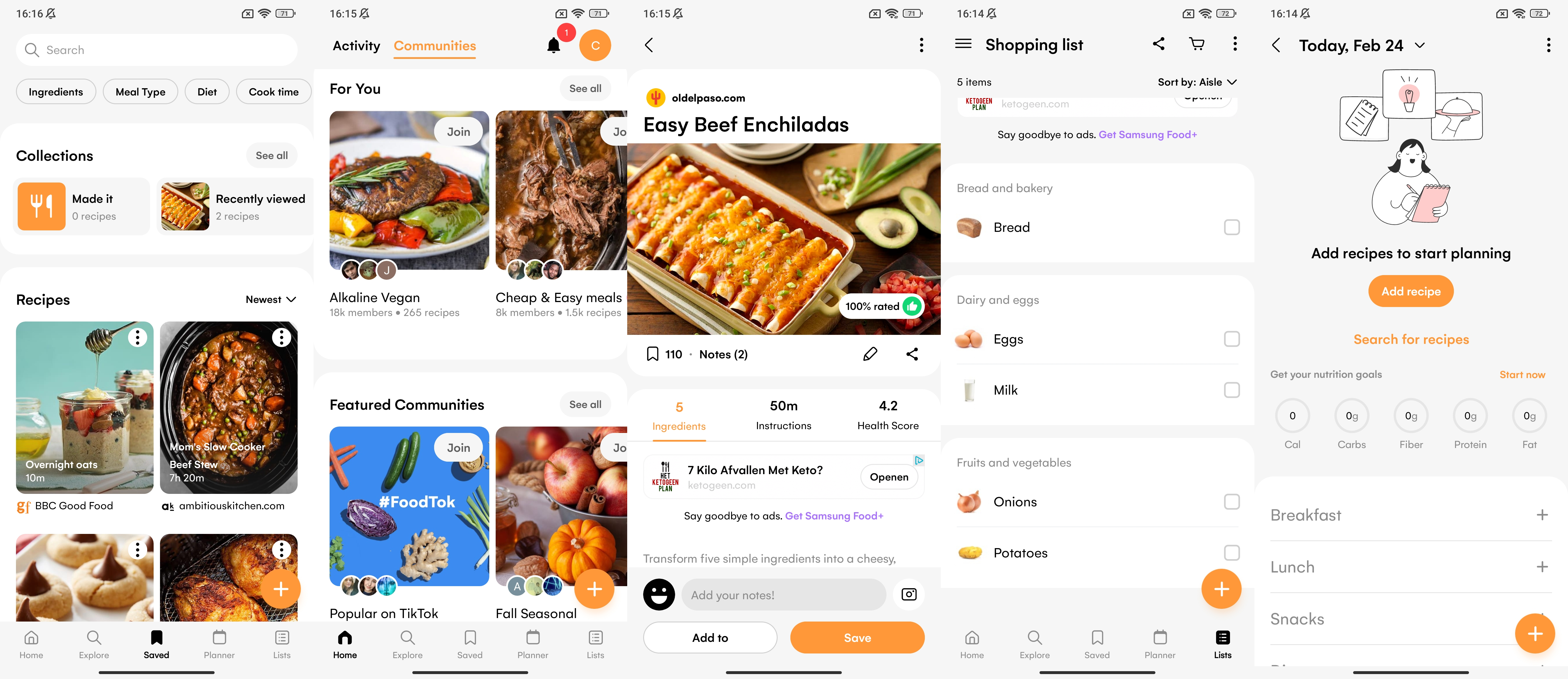
Samsung Food is a multi-purpose cooking app that offers a large collection of recipes and assists in meal and grocery shopping planning. The user can join a large number of communities based on various cuisines and diets, such as vegetarian recipes, healthy eating, low-carb recipes, one-pot wonders, freezer meals, etc. In the communities, the user can view recipes from other people as well as share theirs. The user can also search for recipes within a certain community and apply filters, such as ingredients, meal type, diet, and cooking time. The user can also follow a specific creator. The recipes can be personalized by editing the ingredients manually or using AI for healthier alternatives. Another feature of the app is that the user can save recipes from the web and add them to the shopping list. Also, the app has a meal-planning feature. The user can add recipes to specific days and specific meals. Also, the app displays the total nutritional value, such as calories, carbs, fiber, protein, and fat, of the added recipes. The created meal plan can be shared with other users. Lastly, the app has an integrated shopping list, and the ingredients added to the list can be sorted by aisles or recipes. The shopping list can also be shared with others. Overall, the app has an intuitive interface and minimalist design.

Mealime is an app that helps create meal plans and shopping lists based on that. The user starts by indicating the typical number of servings per meal, as well as allergens or food dislikes. Then, the user can choose from a large variety of meal plans offered in the meal plan section. The meal plans are sorted by various categories, such as Mediterranean, vegetarian, baked, BBQ & Grilling, Soups, Stews & Chillis, etc. After adding the recipes and the number of servings per dish, the app automatically creates a shopping list with all the necessary ingredients. The user can go grocery shopping or use the integrated online shopping option, where the ingredients can be ordered from one of the local stores. A distinct feature of the app is that it keeps track of the amount of food waste saved by creating meal plans and reusing the same ingredients in different dishes. Also, the user can add their recipes, either manually or by importing from the web. Overall, the app has a minimalist and intuitive interface.
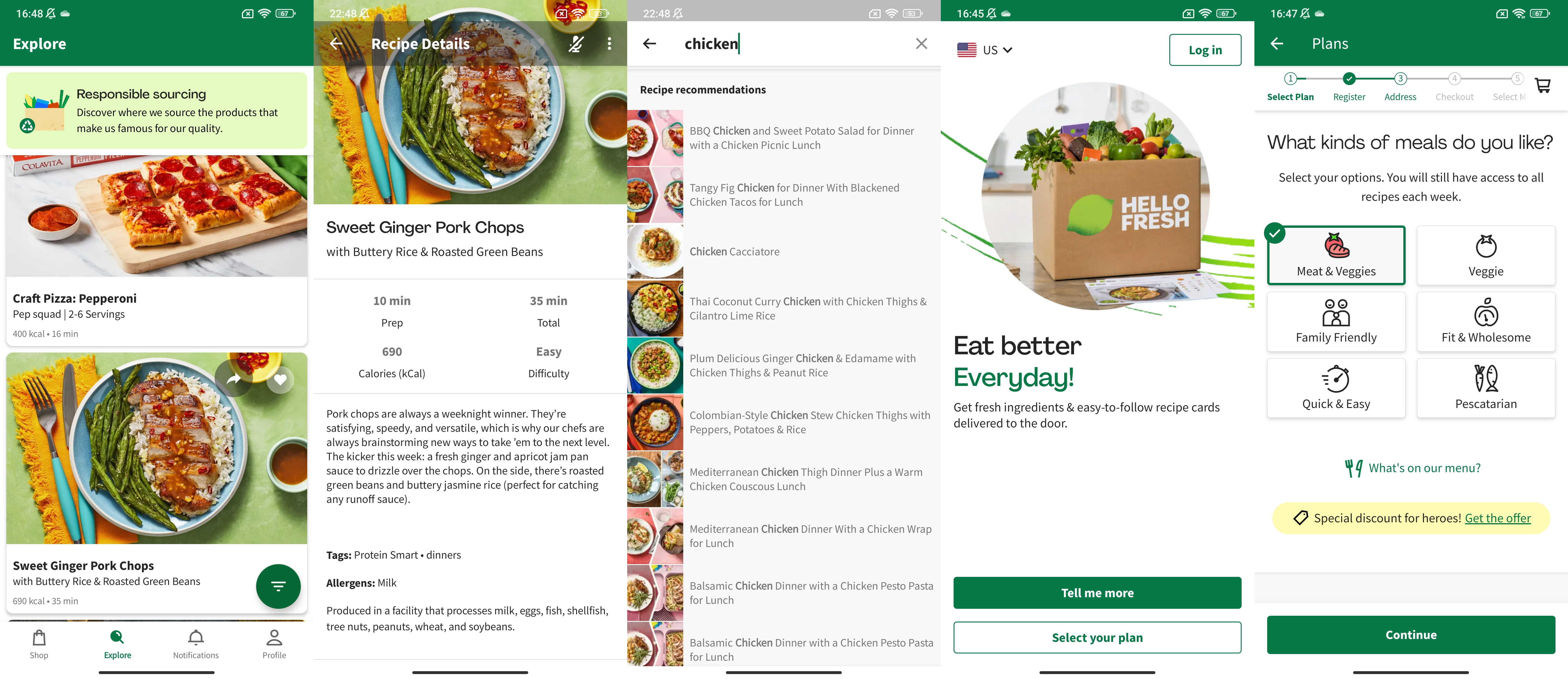
HelloFresh is a meal-planning app with an emphasis on choosing meal plans and getting ingredients for the selected meals delivered to your doorstep. The user starts by indicating their preferences and the number of servings per meal. The app features a large collection of recipes that can be filtered based on cooking time, nutritional value, ingredients, and cuisines. The ingredients for the selected meals can be ordered directly from the app. The app has a green and minimalist design with a limited number of features.
Meal Planner – Plan Weakly Meals
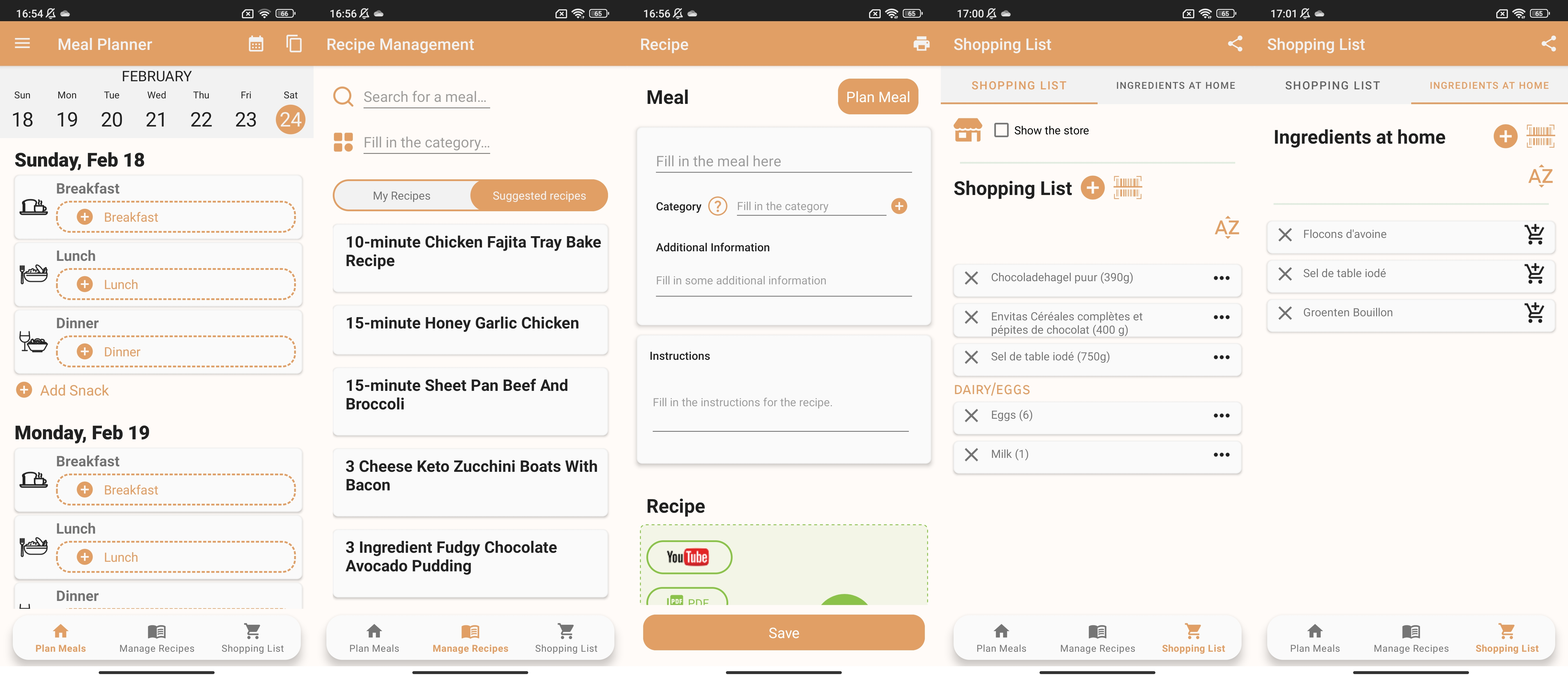
Meal Planner is a simple meal-planning app. The app features an agenda where meals can be added to different days and different meals. The created meal agenda can be shared with other users. The app also features a recipe tab, where the user can add their recipes as well as select from ones suggested by the app. Lastly, the app has an integrated shopping list, where the ingredients can be added manually as well as by scanning a barcode. The user can also keep track of the ingredients already available at home. The app features a minimalist design with limited features.
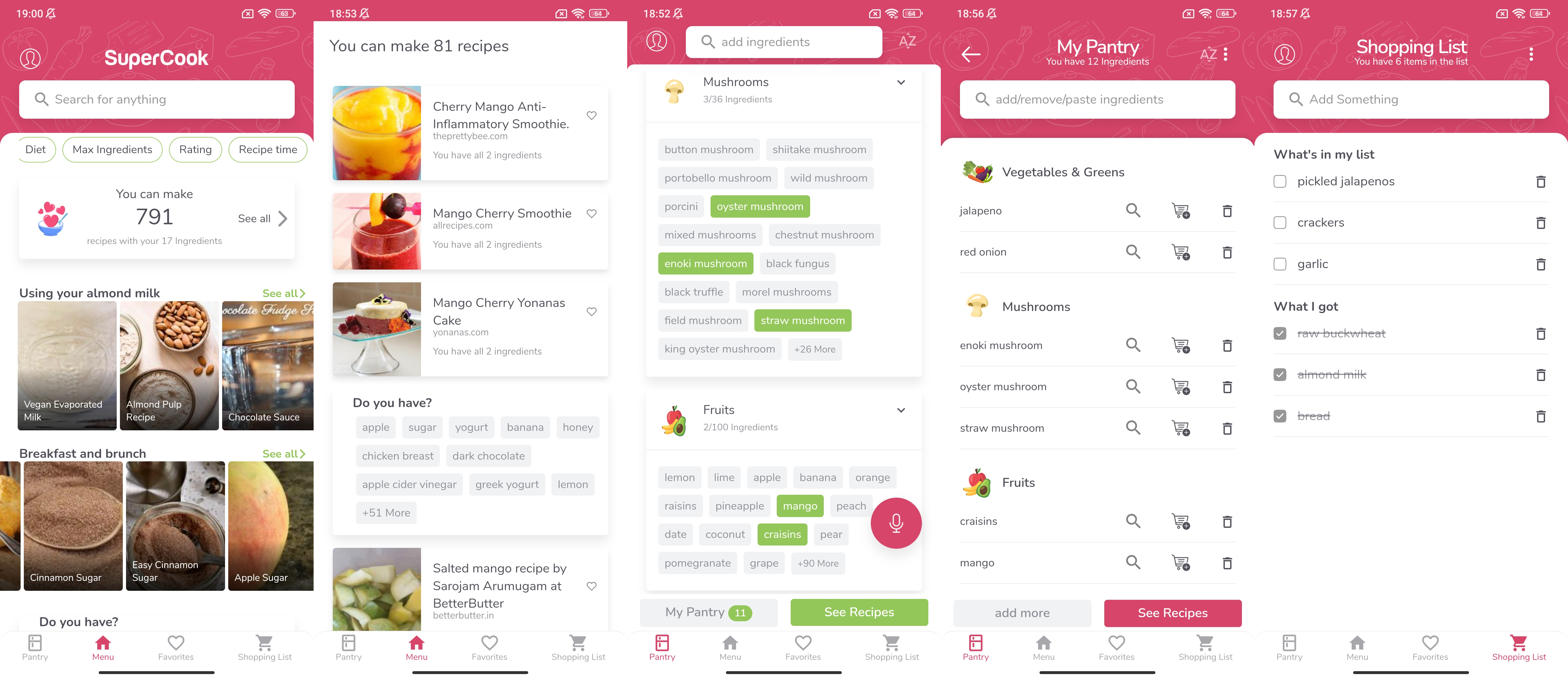
SuperCook is a recipe-suggesting app. The user can add ingredients available at home and based on that the app will suggest various recipes. A distinctive feature of the app is that the user can add ingredients to the virtual pantry via voice input. Also, the app assumes that salt, pepper, and water are available by default. The app has a large variety of categories and corresponding ingredients that can be added by pressing on an item. This presents an advantage as the user does not have to type in the ingredients manually. After selecting all the ingredients, the app suggests recipes that can be filtered by diet, rating, cooking time, meal type, key ingredients, etc. It is also possible to exclude or include additional ingredients. Also, the user can save recipes to favorites. Additionally, the app has an integrated shopping list. The user can add items that are running out to the shopping list directly from the virtual pantry. The app has a simple and intuitive interface equipped with unique features.
SideChef: Recipes & Meal Plans
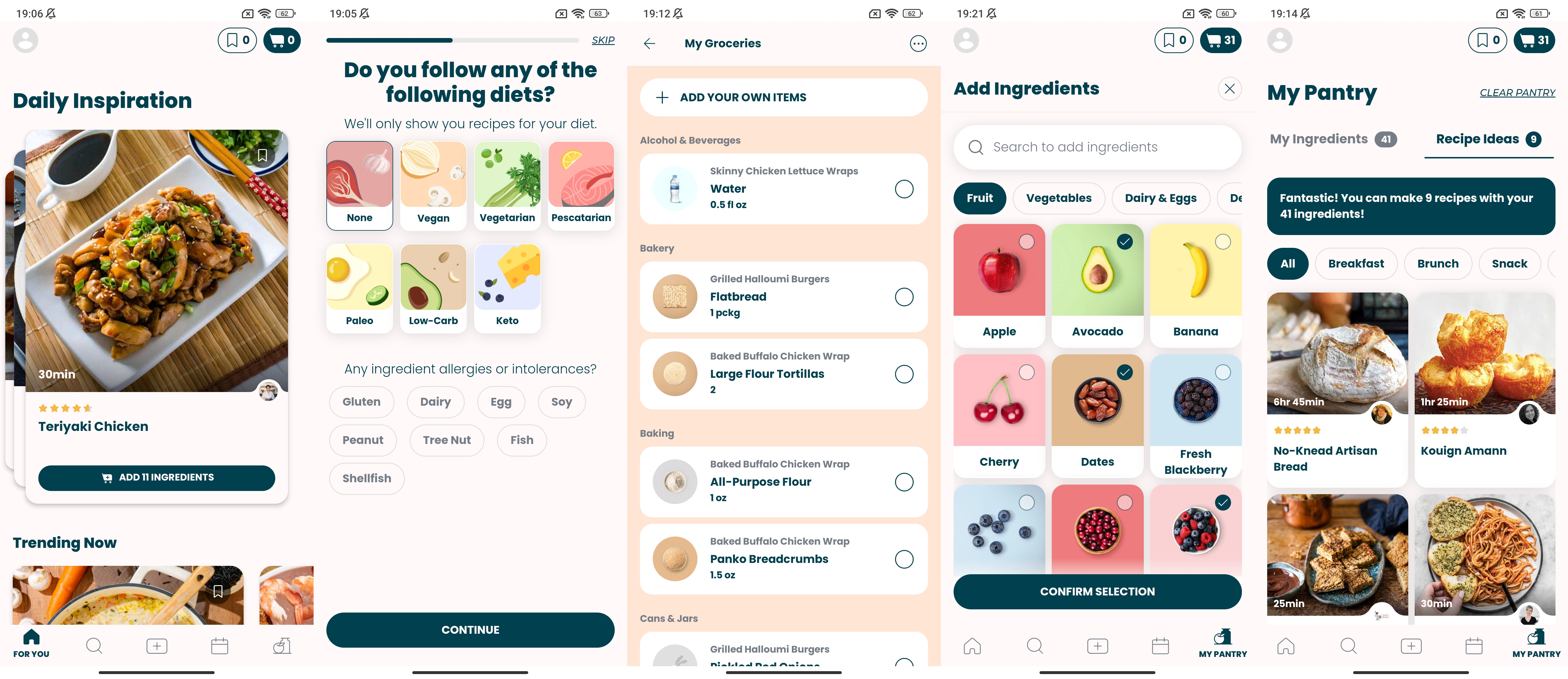
Side Chef is a versatile meal-planning and recipe-suggesting app. The user receives recipe suggestions tailored to the user’s dietary preferences as well as allergens and dislikes. The recipes can be added to specific days of the week, and the serving size can be adjusted as well. The user can also add custom recipes or import from the web. After completing the meal plan, the user can add all the ingredients required for the recipes to the shopping cart. The user can add additional ingredients manually if necessary. The app also features a virtual pantry and corresponding recipe suggestions similar to previous apps. A unique feature of the app is that the pantry can be automatically prefilled with basic ingredients, such as dairy products, grains, sauces and condiments, spices and seasonings, etc. Then the user can manually add or remove items. Similar to SuperCook, the items can be added by pressing on corresponding pictures from the selection. Overall, the app has a simple and minimalist design.

Eat This Much is a meal-planning and recipe-suggesting app. The app automatically creates a meal plan tailored to the physical parameters of the user (height, weight, sex, fat contents), lifestyle, dietary preferences, and allergens. The curated meal plan can be manually adjusted by the user. Additionally, the app offers a wide variety of recipes and collections created by other users. Also, the user can add specific ingredients to the meal plan and set them as recurring. The ingredients can be added by choosing from the app selection or scanning a barcode. The paid version of the app also includes a virtual pantry and an integrated shopping list. Overall, the app emphasizes the weight goal of the user and the nutritional value of the ingredients.
The main features of the apps were summarized and compared in the table below.
| Requires sign up | Recipe suggestions | Social media aspect | Shopping list | Meal planning | Add own recipes | (Explicit) use of AI | Dietary preferences | Allergies | Food waste awareness | User physical profile | Expiry date tracking | Unique features | |
| Samsung Food | Y | Y | Y | Y | Y | Y | Y | Y | N | N | Y | N | |
| Mealime | Y | Y | N | Y | Y | Y | N | Y | Y | Y | N | N | |
| HelloFresh | N | Y | N | N | Y | N | N | Y | N | Y | N | N | |
| Meal Planner | N | Y | N | Y | Y | Y | N | Y | N | N | N | N | Barcode scanner |
| SuperCook | N | Y | N | Y | N | N | N | Y | N | N | N | N | Voice input |
| SideChef | Y | Y | Y | Y | Y | Y | N | Y | Y | N | N | N | Prefill pantry |
| Eat This Much | Y | Y | N | Y | Y | Y | Y? | Y | Y | N | Y | N | Automatic meal planning, tutorial, barcode scanner |
As can be seen, none of the apps mentioned above include expiry date tracking. Therefore, the apps with this specific functionality are investigated below.
Expiry Date Tracking Apps
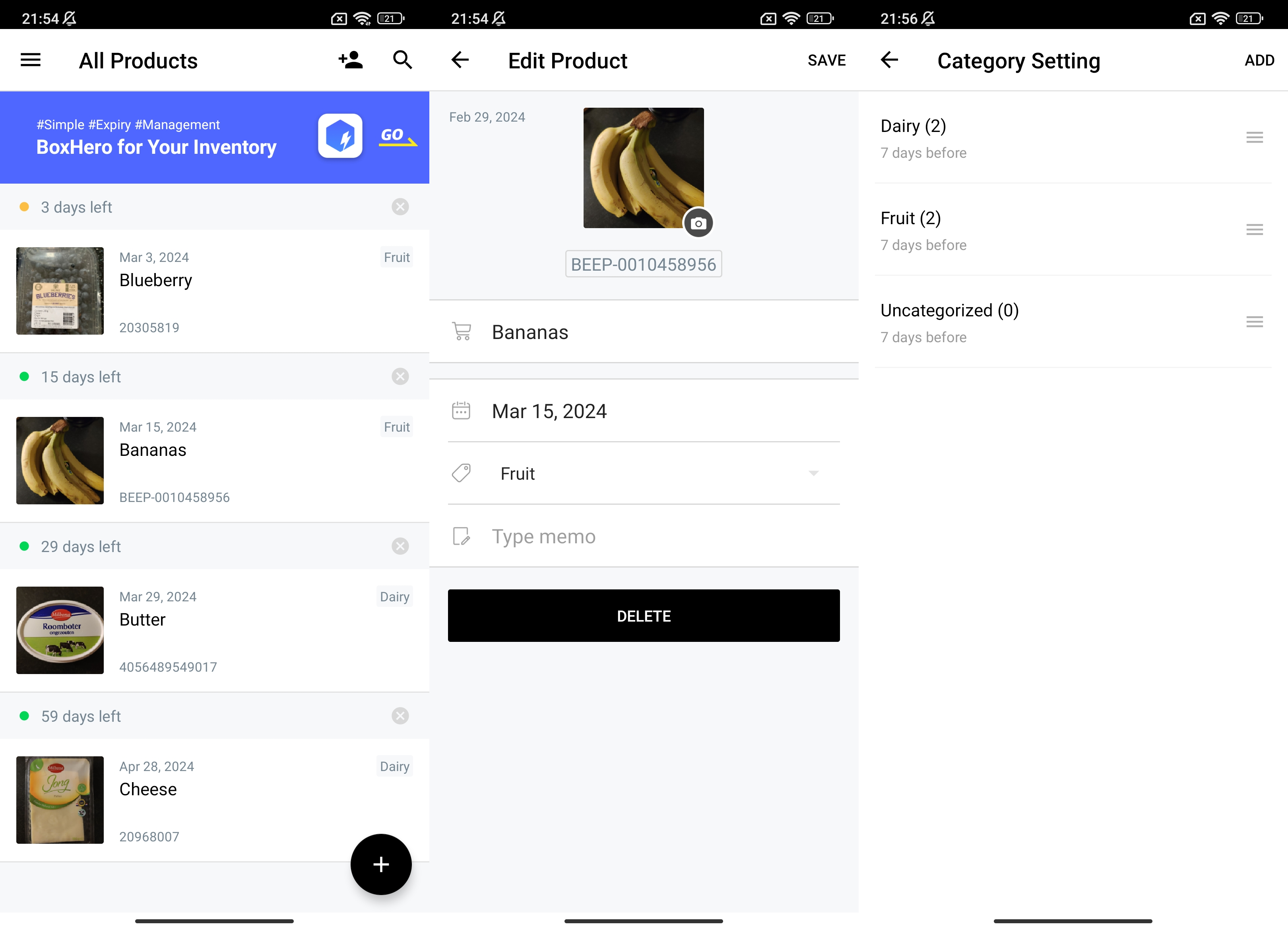
BEEP is an app that keeps track of the expiry date of products. The products can be added to the inventory by scanning the barcode and the expiry date indicated on the packaging. Alternatively, the user can add items manually via text input. The user also has an option to add a picture of the item. The items are displayed in the list with items close to the expiry date being on the top. Additionally, the items in the inventory can be sorted by categories specified by the user. The user can create groups and invite other users, for example family members. The app also sends notifications once certain products are about to expire. Overall, BEEP is a simple app with minimalist design and limited functionality.
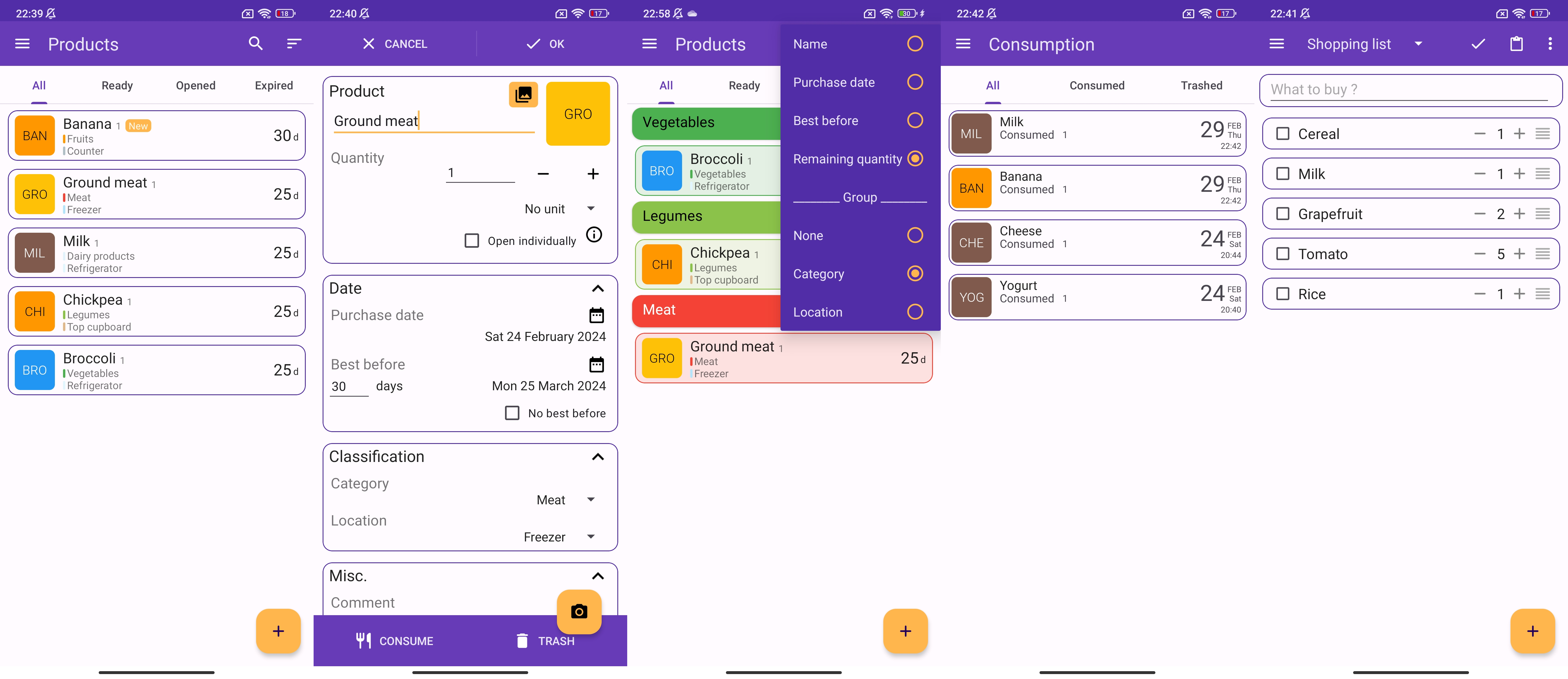
Best Before is an expiry date managing app. Similarly to BEEP, the items and their corresponding expiry dates can be added to the pantry. Additionally, the items can be classified by food category and storage location. The user can also set notifications for each individual item in case of expiry or as a reminder after opening. The user can sort items in the list by name, purchase date, best before date, or remaining quantity. Also, the items can be grouped by category or storage location. Overall, the items in the pantry are divided into 3 categories: items ready to eat, items that have been opened, and items that have expired. The items that have expired are added to the corresponding section automatically. Additionally, in the “Consumption” section, the user can keep track of all the items that have been consumed and/or trashed. The app also features a “Shopping list” section. In conclusion, Best Before is an effective tool for food tracking and expiry date managing; however, the interface is difficult to navigate at first.
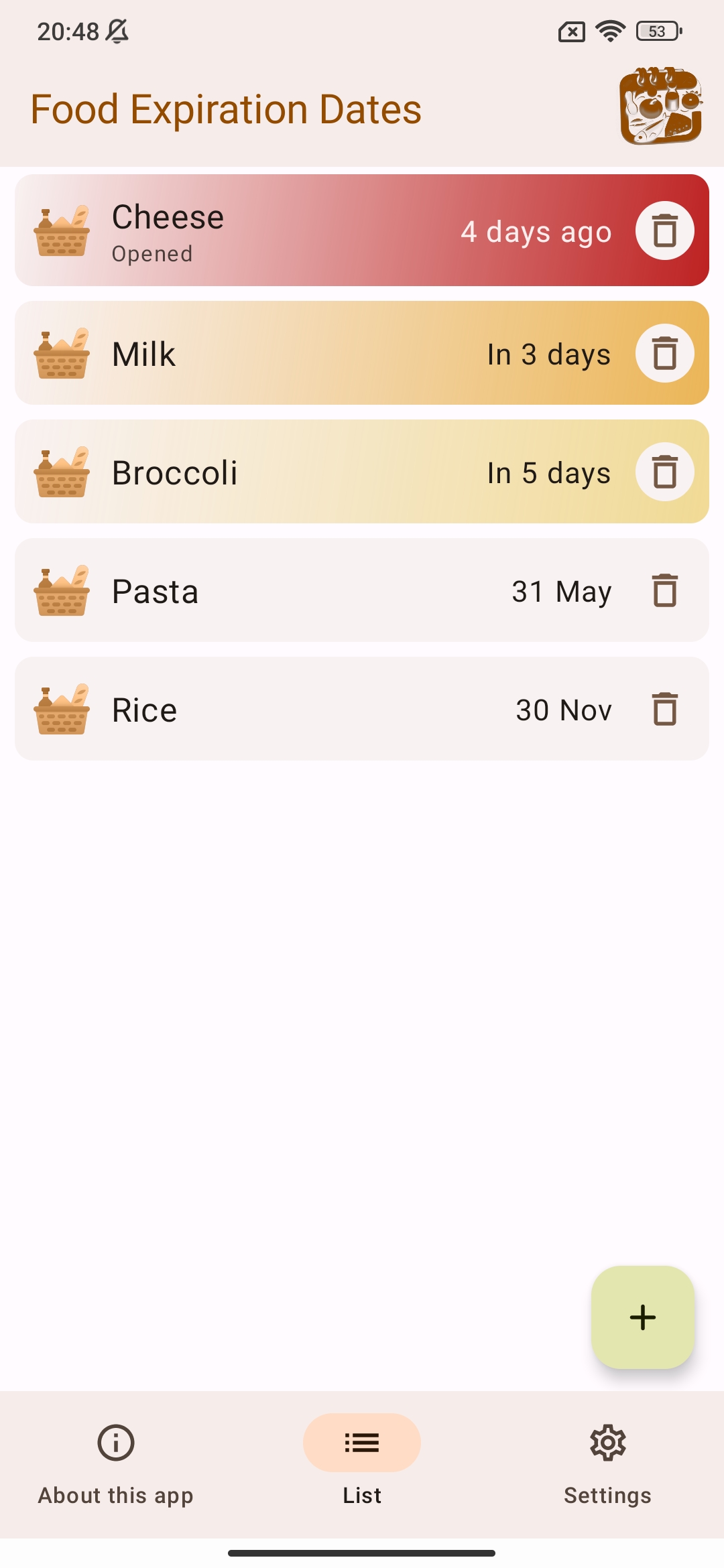
Food Expiration Dates is an app that keeps track of the expiry dates of the items in the pantry. Similar to the previous two apps, the items in the list are shown with the items closest to the expiry date being on top. The app has a simple and minimalist interface without any additional features.
User Studies
Survey
To investigate whether there is a demand for an expiry-tracking and recipe-suggesting app, a survey was conducted. The results and the analysis of the survey are presented below.
Results
The questions can be divided into two main categories: general questions regarding user food habits and knowledge about food waste, and questions related to the app design and functionality. The first part of the questionnaire aims to compare the data acquired from the literature study with the real-life responses, and the second part aims to aid app development and identify the functionality that the users require the most.
The first question asks the respondent to indicate their age. As can be seen from Figure ?, the majority of the respondents (61.5%) are between 18 and 24. As for other age groups, 17.3% (9 respondents) are between 35 and 44, 15.4% (8 respondents) are between 25 and 34, 3.8% (2 respondents) are between 55-64, and 1.9% (1 respondent) are between 45 and 54. Thus, the survey includes responses from a large variety of age groups, with most responses coming from younger users.
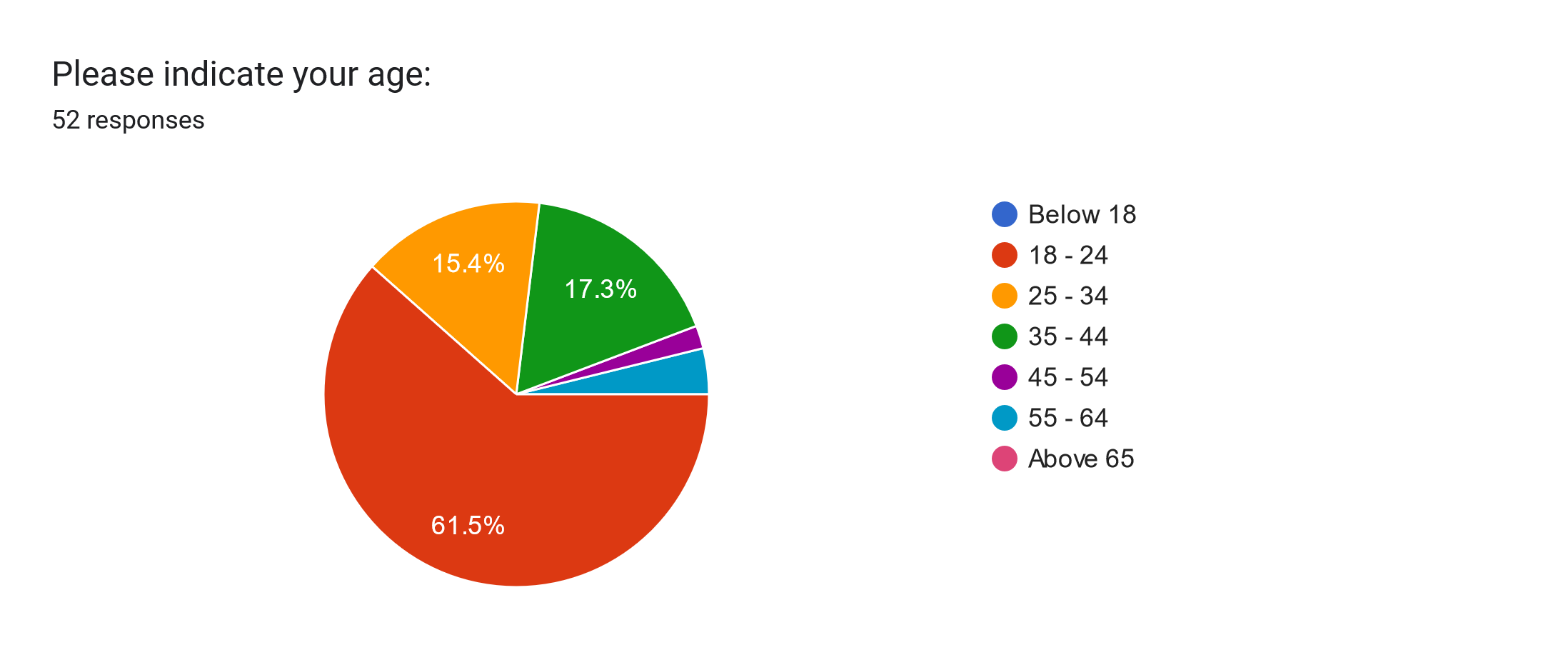
In the next series of questions, the respondents are asked to indicate to what extent they agree with the presented statements. For the first statement, “I frequently throw away food,” the majority of the respondents, namely 67.3%, responded negatively, while 21.2% neither agreed nor disagreed.
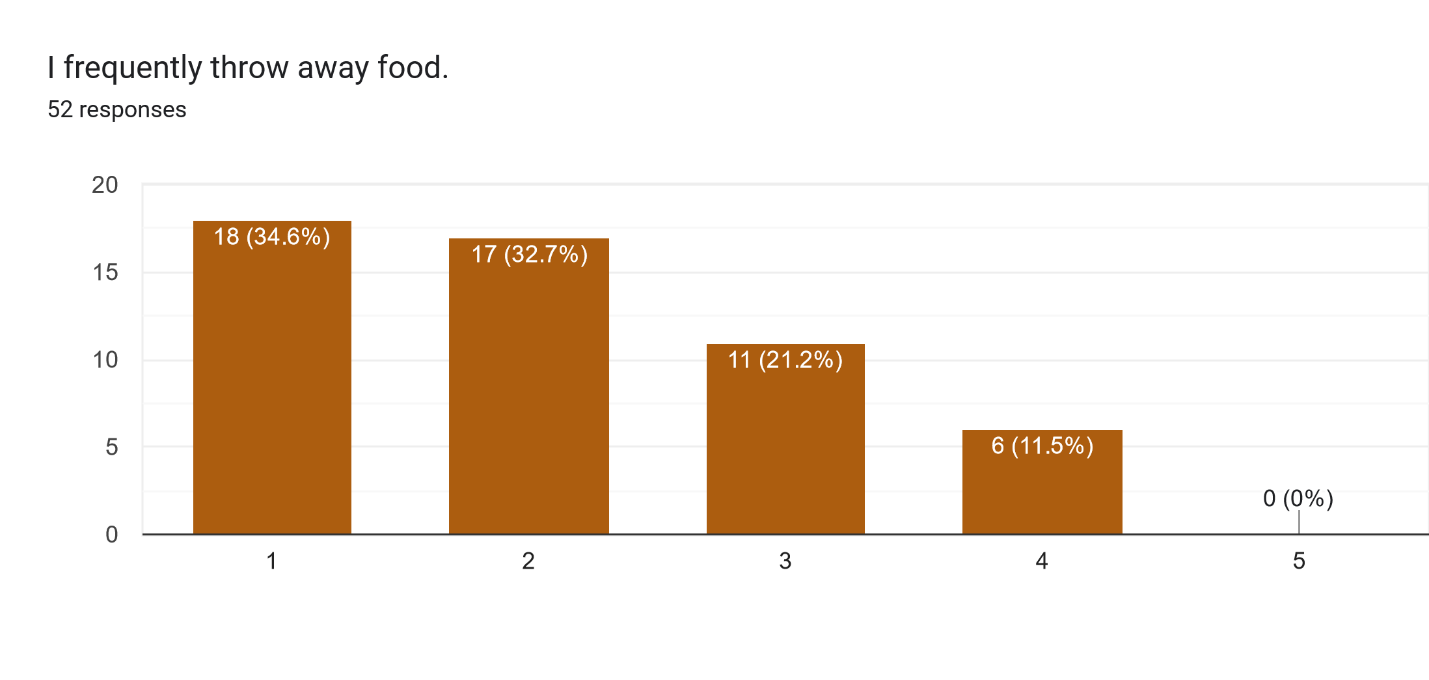
As for the next statement, “I throw away a large amount of food,” most respondents (92.3%) replied negatively.

In response to the statement “I often forget about the food in my fridge,” a large portion of the votes (57.7%) replied negatively, 21.2% remained neutral, and 21.2% replied positively.

For the question "I cook more than I can eat", 63.5% replied negatively 15.4% neither agreed nor agreed, and 21.2% replied positively.
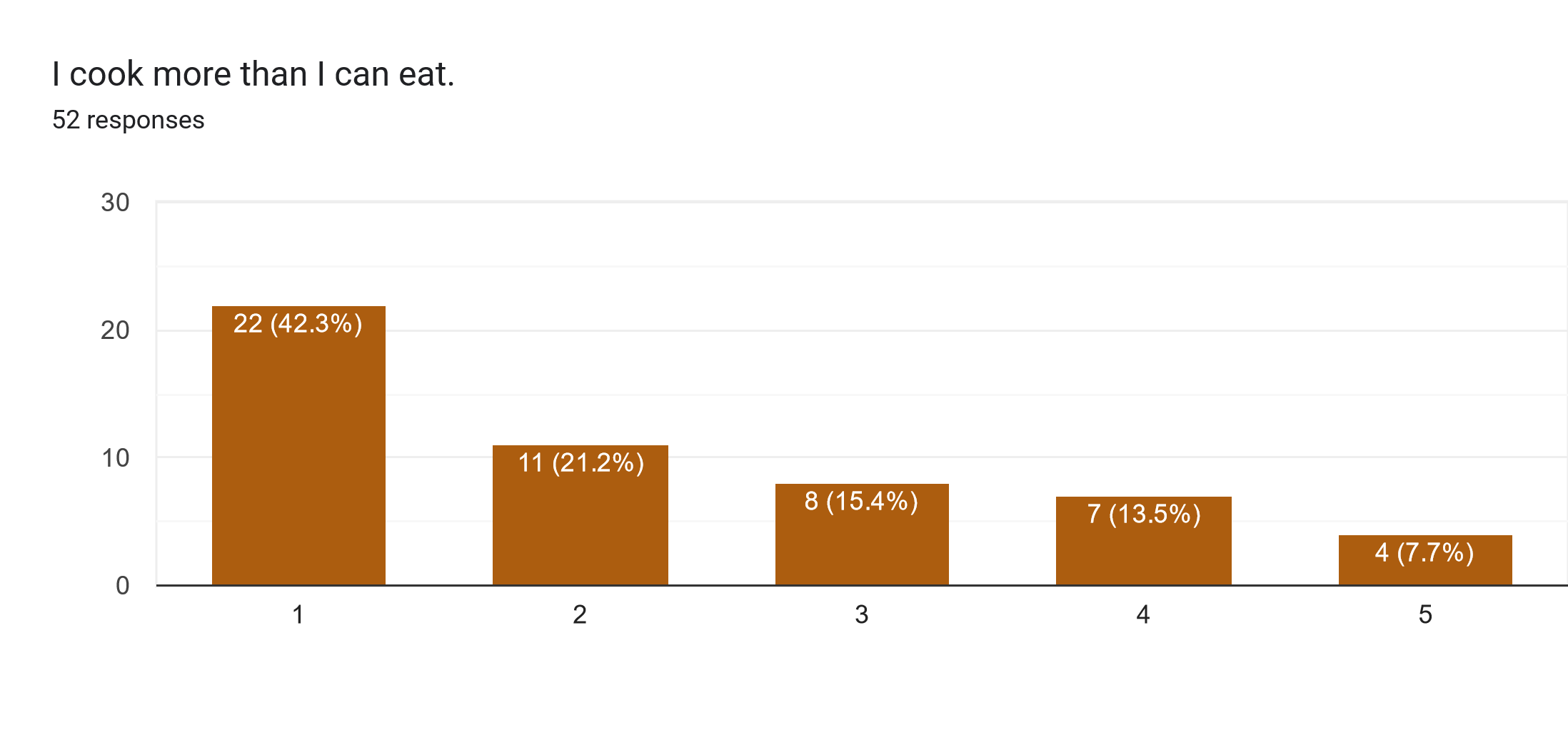
Regarding the statement “I don’t reuse leftovers,” the majority of the respondents (86.5%) replied negatively.
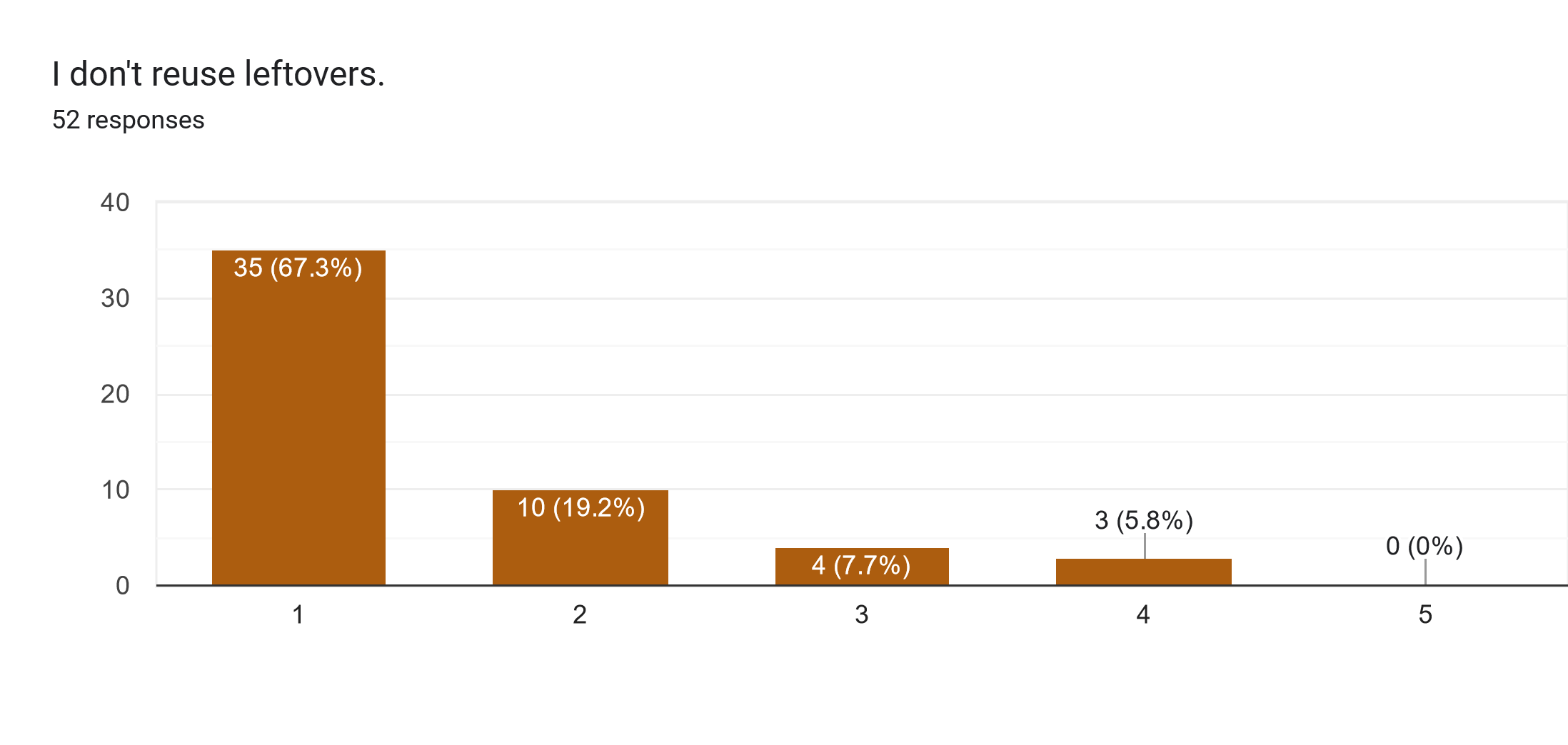
The next statement, “I don’t cook / don’t want to cook because I” aims to find the most common reasons why people avoid cooking. For half of the respondents (55.8%), the statement is not applicable, while 36.5% indicate that they don’t have enough time for cooking. As for the rest, 13.5% indicate that they don’t know what to cook, and 7.7% don’t cook well. Other responses attribute not cooking mainly to laziness.

As for the next two statements, “I am aware of the problem of food waste” and “I am willing to reduce the amount of food waste I produce,” the majority of votes (78.8% and 82.7%, respectively) were positive.
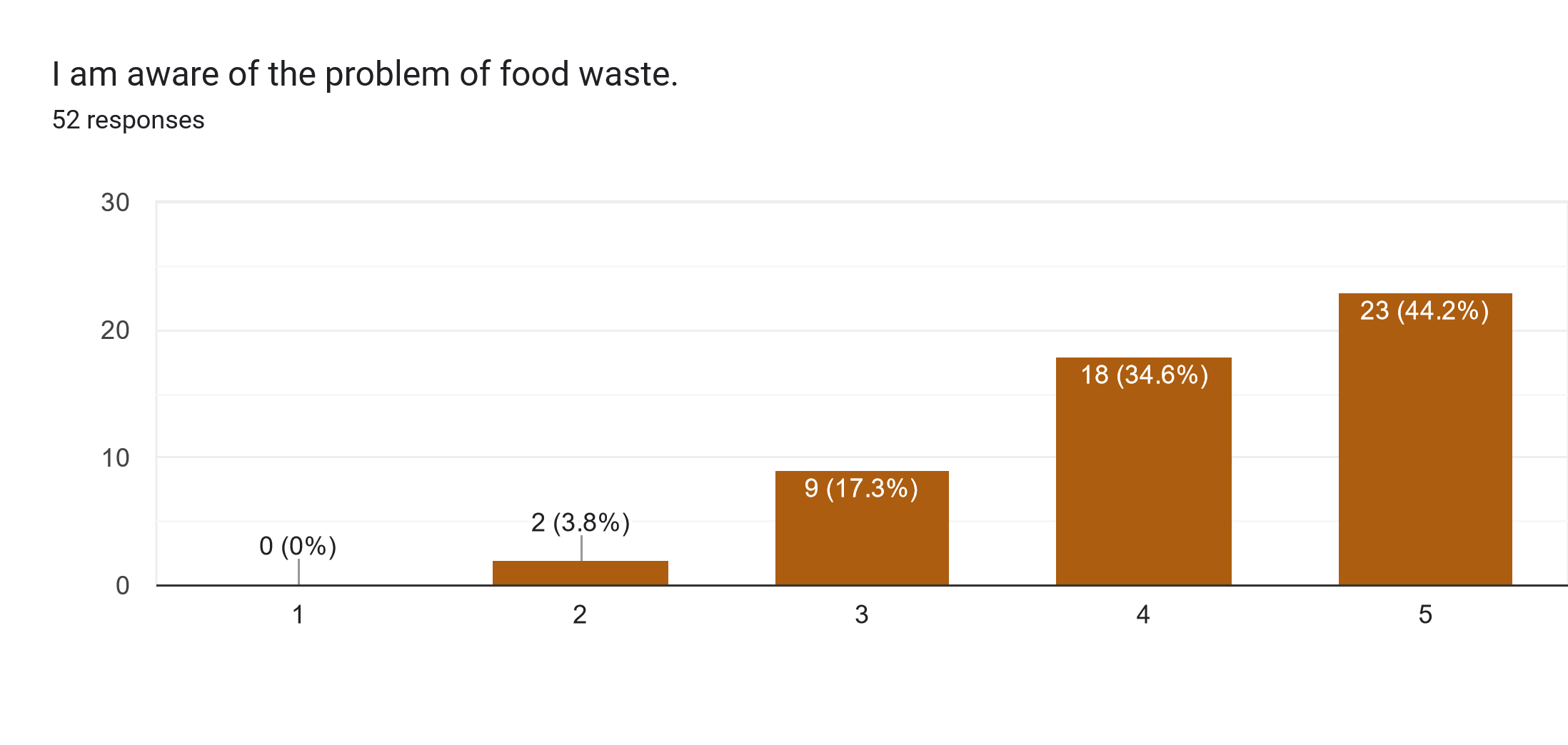
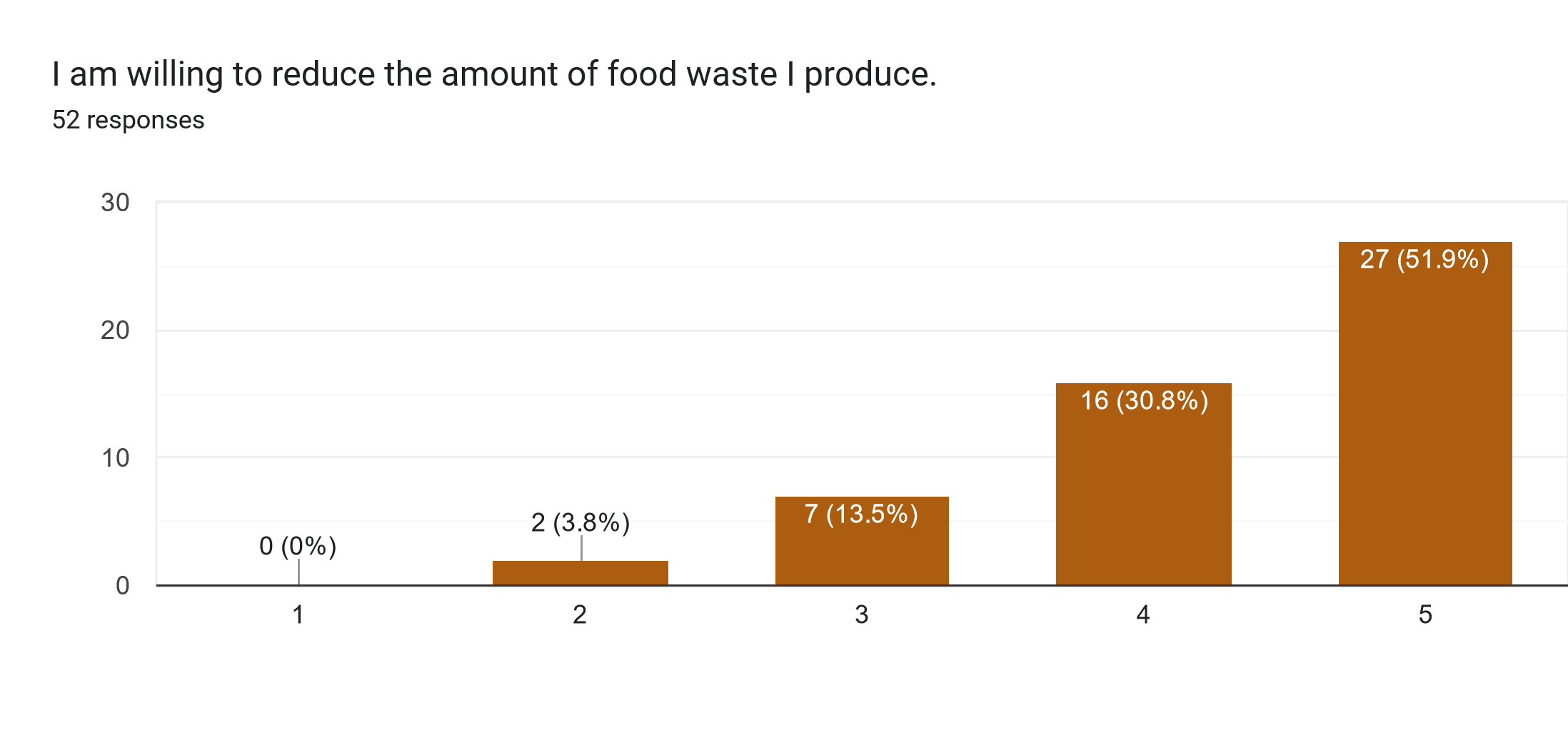
The second part of the questionnaire is related to app design and functionality.
First, the respondents were given a brief description of the app:
"To combat food waste at a consumer level, we are making a mobile application that keeps track of ingredients available at home and suggests recipes based on that."
For the statement “Would you consider using such an app," 30.8% of respondents replied “Yes,” and 50% replied “Maybe.” Thus, the answers indicate that there is an interest in such an app.
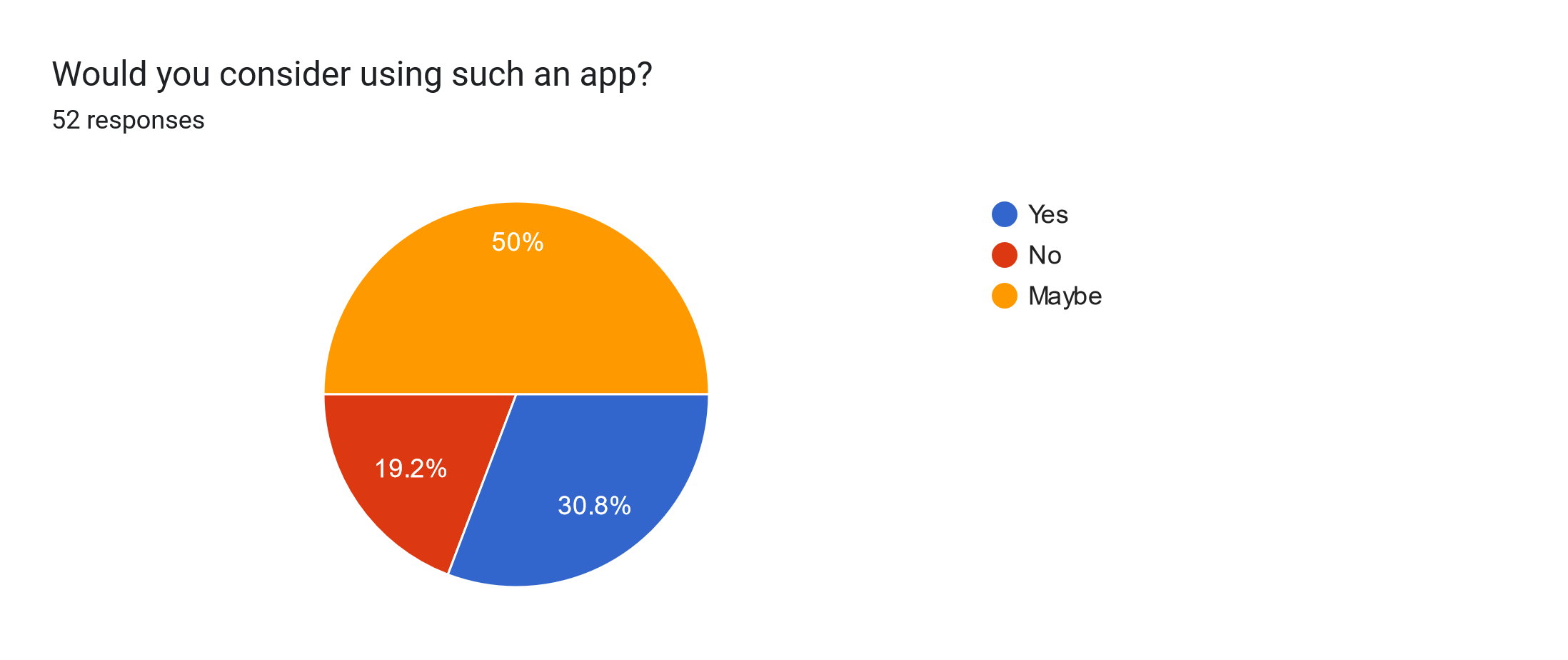
The next three questions ask the respondent to choose a mock-up that looks most appealing. The results can be seen in the figures below.
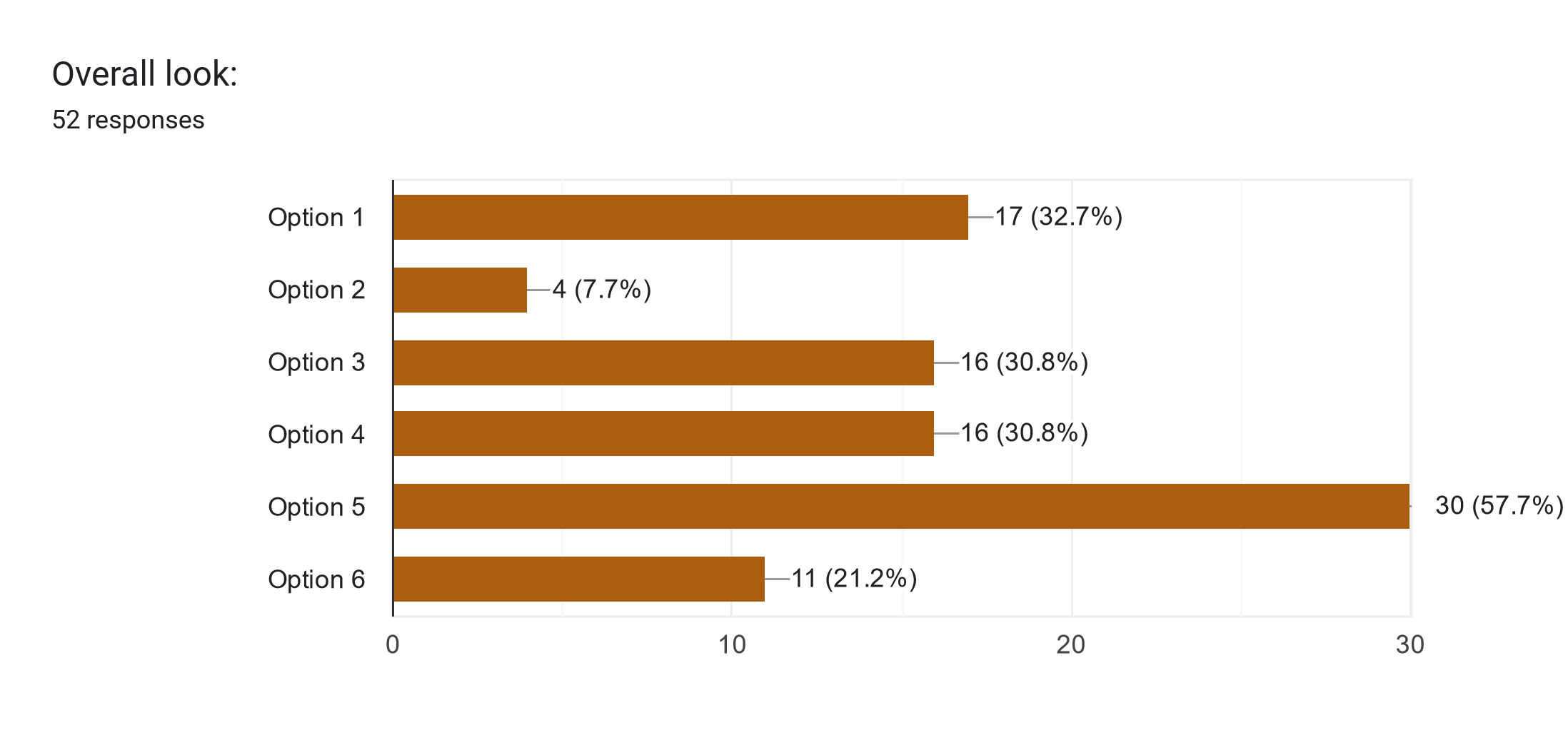

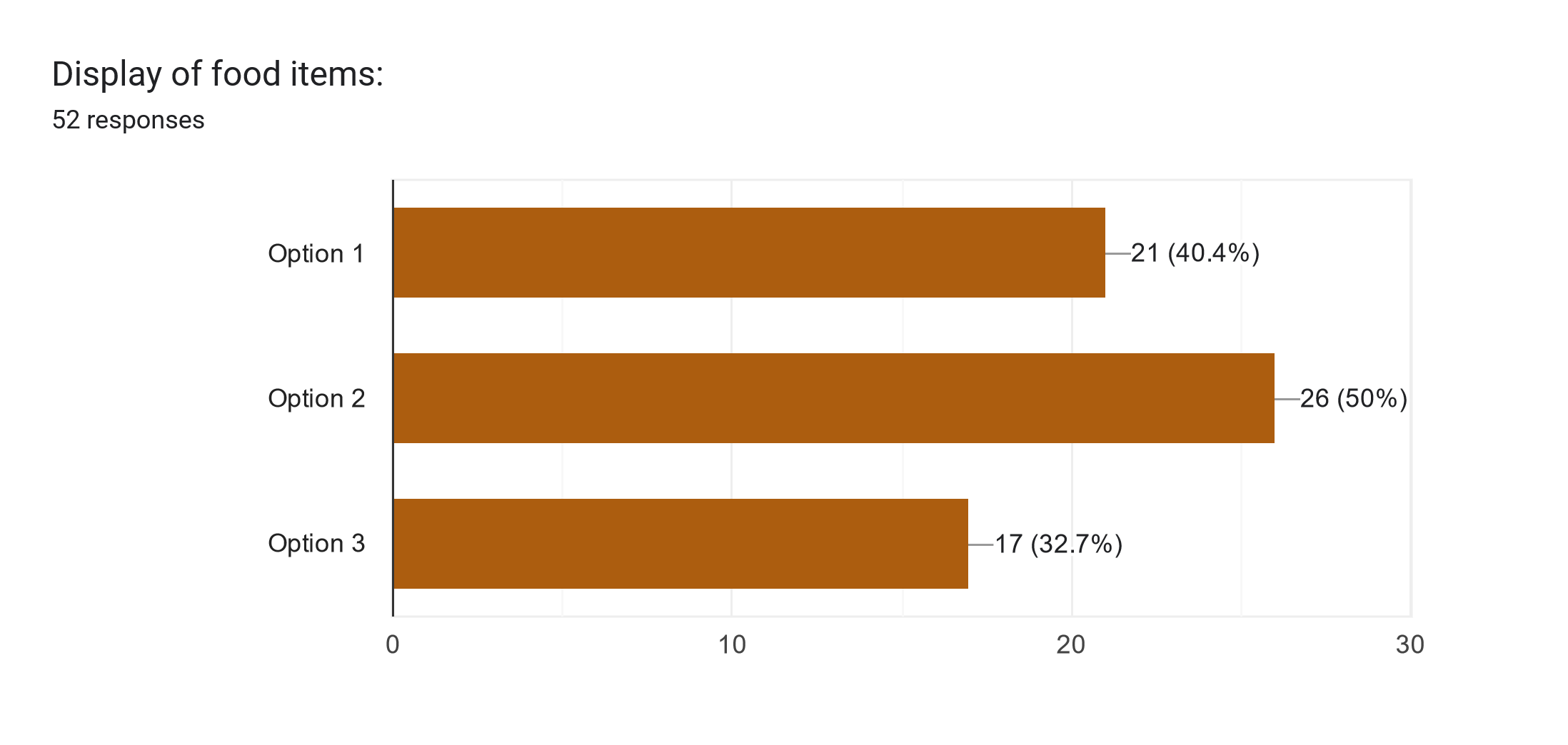
The next question is related to the preferred method of inputting items into the virtual inventory. The most popular options are via taking a picture and via text input with 31 and 27 votes, respectively.
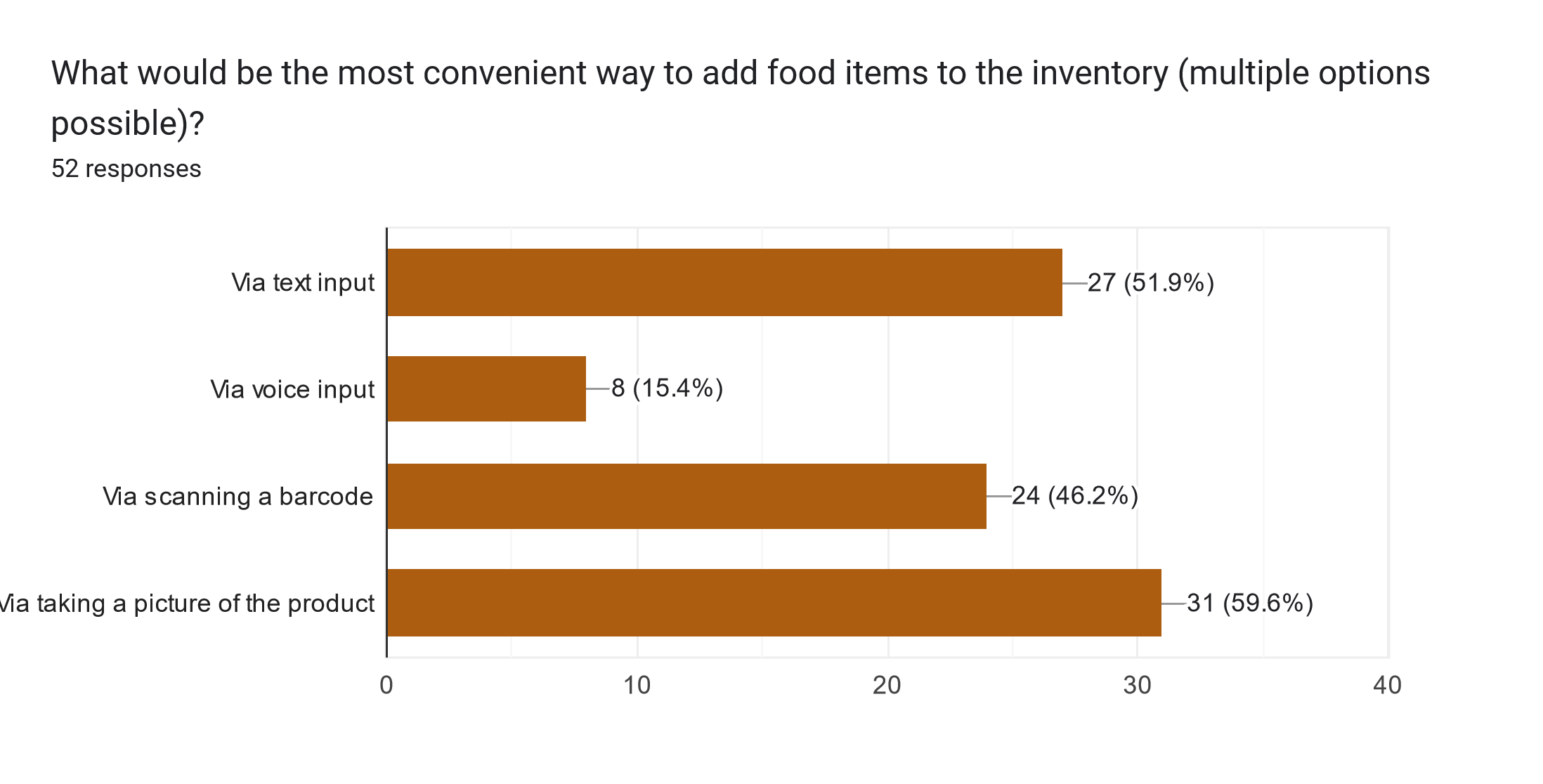
The following question reads “What additional features would you like to see in an app?” The most popular request with 45 votes is to notify when the product in the inventory is about to expire. Also, adding the expiry date to the product automatically and recipe filtering were popular choices, with 31 and 32 votes, respectively.
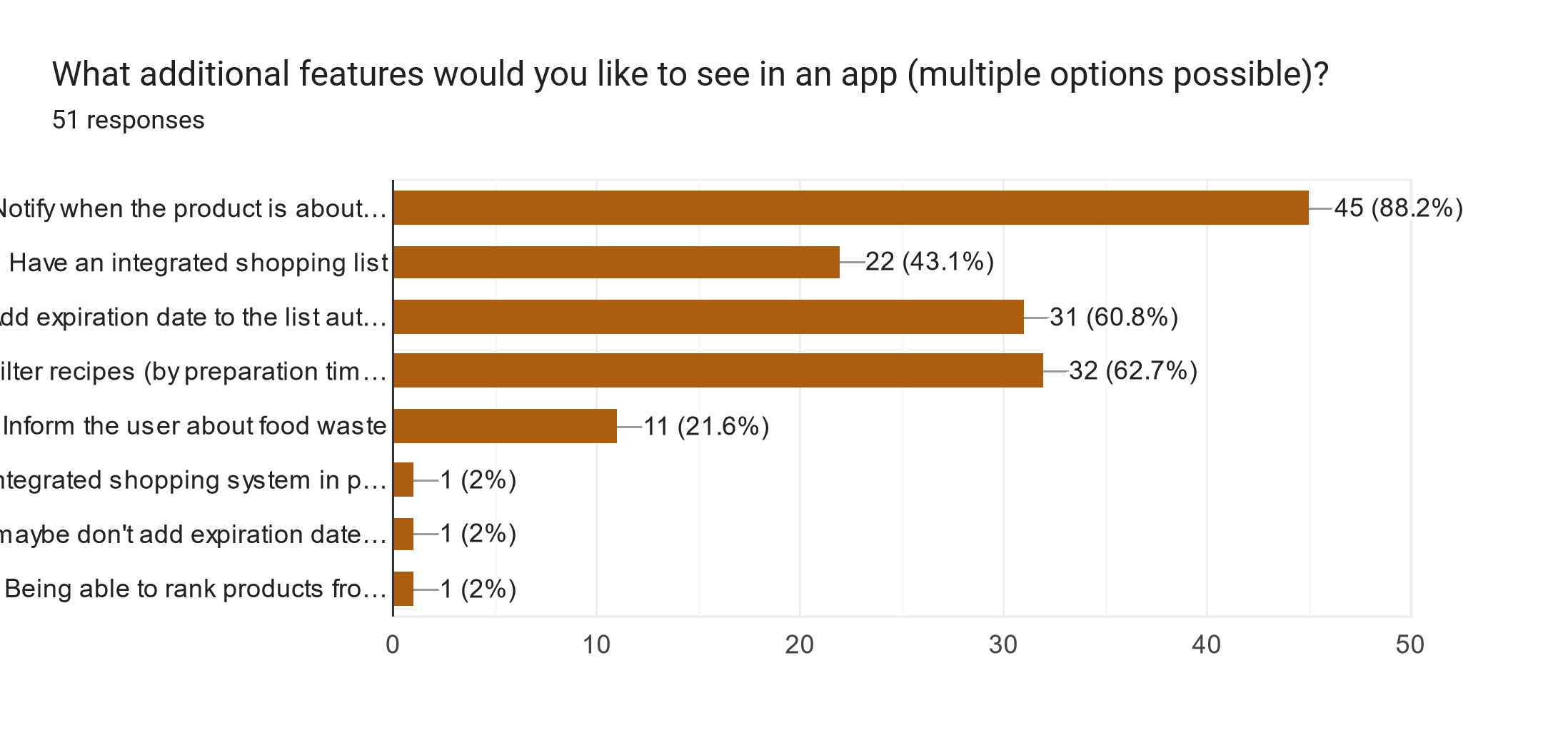
Finally, the respondents are asked to provide additional comments or suggestions. In total, 11 responses were submitted. These can be found below.
| Nice idea guys |
| Using expiration dates given by manufacturer labels is problematic as they are completely arbitrary. I often have items in my fridge weeks beyond their stated expiration date but still in a very good condition. I am fairly convinced manufacturers inentionally set very early expiration dates to boost their sales |
| It would be interesting to see how you implement expiration date compared to when the food actually spoils. Of course you could send a notification of when food is about to hit its expiration date, but it would be much more useful if you could actually estimate how far away the food is from spoiling. |
| You could provide advices on how to reduce use of packaging - list of brands/locations/shops where the same products can be bought with less plastic packaging. |
| Inform me about where I’m supposed to store food (fridge or no) |
| The app should have a dark theme. |
| The ways I had for adding food items are nice and fast, however they do not account for the expiration date as cameras can not see when a piece of food will expire especially when the food is in a carton since the expiration date could just happen to be on the back of the product. the same goes for the barcode, as far as I am concerned, barcodes do not have any information on expiration date on them as the barcode is the exact same on every product of a single type, I would like to know how the app tracks when a product will expire. |
| For the rest, I like the idea, I believe things like this have been done before (Fridgely, BEEP, Best before etc) so I would like to know what your selling point is. There is definitely a market (and a need!) for such a product as food waste is a huge issue. Good luck :) |
| This kind of app should be possible without an account, I'm a bit wary about user data harvesting. |
| would love tips about increasing lifespan or freshness e.g. putting lemons in water |
| Being able to connect the app to an Albert Heijn bonus kaart or Jumbo extras account to avoid manual input |
| I really like the concept of this app, would definitely use if it delivers on this concept |
Discussion
Several conclusions can be drawn from the results of the survey. Firstly, the sample size of 52 is too small and, therefore, not representative of the full population. Therefore, definitive conclusions cannot be drawn. Moreover, the information provided by the literature might not agree with the questionnaire results.
Secondly, it can be observed that most of the respondents (61.5%) are in the age group of 18-24. In other words, this age group represents students and/or recent graduates. Therefore, it can be presumed that the amount of food waste in this age group correlates with limited finances. As noted by [7], financial concerns create a stronger motivation to limit the amount of food waste than environmental or social ones.
Another conclusion that can be drawn from questions 2 and 8 specifically is that there is a correlation between the amount of food waste and the awareness about food waste in general. As mentioned by [7], concern about food waste is a significant factor regarding food waste reduction. To explore this hypothesis more, a heatmap was created. The horizontal axis represents the responses to the statement “I frequently throw away food,” and the vertical axis represents the responses to the statement “I am aware of the problem of food waste.” The numbers on the heatmap indicate the number of people who have selected a specific answer. As can be seen, the respondents who answered 1 or 2 (Strongly Disagree and Disagree, respectively) are highly aware of the food waste problem with scores of 4 and 5 (Agree and Strongly Agree, respectively). Also, as can be noted, the number of respondents who are aware of food waste but still throw away food frequently is significantly less. Therefore, one of the strategies for reducing food waste could be raising awareness about food waste among the public. More specifically, the users can be informed about food waste via a dedicated info tab in the mobile application.
Lastly, the information collected via a survey is limited and does not provide the full picture of the causes of food waste and food-related habits. Thus, further investigation in the form of interviews is required.
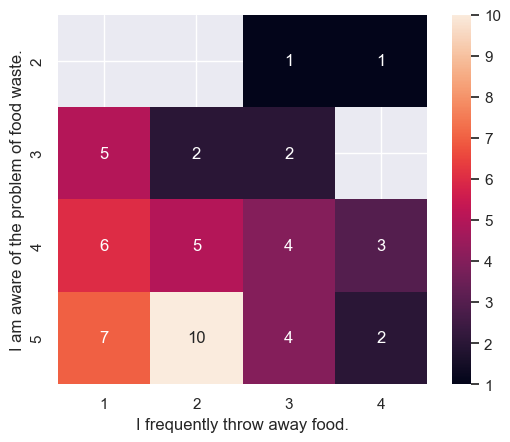
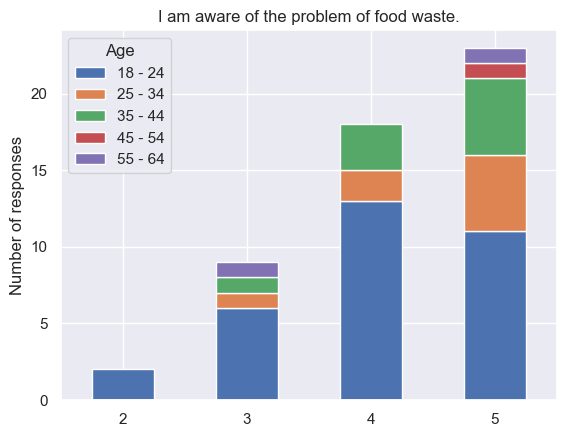
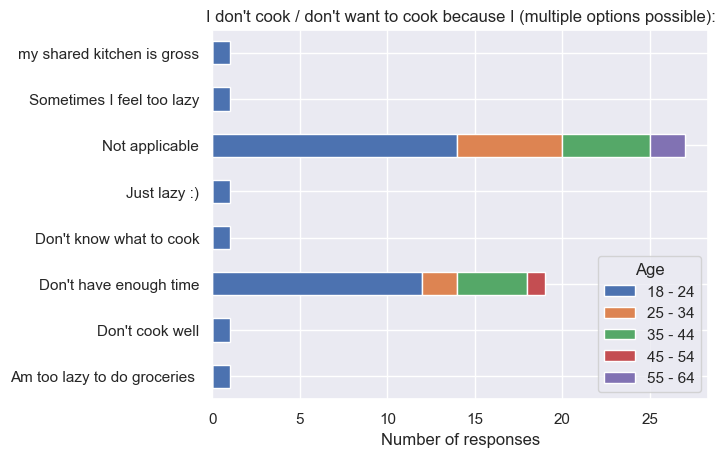

Interview
Interview Robots Everywhere
- How significant do you think the global issue of food waste is, and to what degree do you believe your actions contribute to this problem?
- Would you welcome support in addressing your impact on the issue of food waste, regardless of the specific medium? If yes, can you specify the areas where you would most appreciate assistance?
- How do you personally imagine that current technologies could be used to minimize household food waste? Provide some examples, if possible.
- Our proposed solution is a mobile application designed to combat food waste by suggesting recipes tailored to the user's fridge contents. Additionally, the app may recommend specific, additional products to purchase when the fridge inventory is insufficient. What, in your opinion, are the advantages and disadvantages of such an app? Also, which features, whether mentioned or not in our description, do you view as essential for this application's effectiveness?
- Would you consider it inconvenient to manually enter your kitchen ingredients, their expiry dates and potentially their quantities into the app? To what degree would you prefer an automated input system, like using QR codes or photo analysis for product information?
- How important is it for you to tailor the app's recipe suggestions to match users’ personal preferences and restrictions, like allergies and preferred cuisines? Additionally, are there any other possible customizations you would want the app to offer?
- Are you currently using any existing applications or methods to help reduce food waste in your daily life? If yes, please share your experiences and any limitations you've encountered.
- Are there any concerns or reservations you have about the privacy and security of personal information when using an application that involves tracking kitchen inventory and consumption patterns? If so, please briefly describe them.
- Would you be willing to share your food waste reduction efforts on social media or participate in a community aspect within the app to encourage and inspire others? Generally, would you be interested in the application including any sort of social features?
- How open would you be to trying new recipes and ingredients suggested by the app, especially if they contribute to minimizing food waste?
- How important do you view user interface design in influencing your decision to use and engage with the application regularly? What would be some specific features that you would like to see included in the user interface?
- Would you be more inclined to use the app if it offered incentives, rewards, or discounts related to sustainable practices or reduced food waste? If so, what such rewards would motivate you most?
- Would you prefer the app to offer educational content or tips on sustainable cooking practices to further enhance your awareness and knowledge about reducing food waste?
- Considering potential time constraints in your daily life, how much time would you be willing to dedicate to using the app for meal planning and managing food inventory every day, or week?
- Are there specific social or cultural considerations that you believe the app should incorporate to be more inclusive and relevant to diverse user demographics?
Design related questions
Furthermore we have design related questions for this interview. First of all, the design Aesthetic.
- If you imagine an app that supports you in combatting food waste at home. What kind of feel would you prefer. Use keywords to describe it.
- If you take a look at the following theme of aesthetic (figure 1). Which aspects do you like and which aspects do you dislike? Does it give you the feeling of empowerment and sustainability?
- If you take a look at the following theme of aesthetic (figure 2). Which aspects do you like and which aspects do you dislike? Does it give you the feeling of empowerment and sustainability?
- If you take a look at the following theme of aesthetic (figure 3). Which aspects do you like and which aspects do you dislike? Does it give you the feeling of empowerment and sustainability?
Look at the following interface. This interface is a virtual fridge, it keeps inventory on all the items that are placed in you're fridge and it should give an clear overview opposed to your chaotic fridge. The goal would be to motivate you to waste less food.
5. Take a look at figure 4. What are you're impressions? Do you think this interface is intuitive, clear, pleasant to use and efficient? Also mention why.
6. Take a look at figure 5. What are you're impressions? Do you think this interface is intuitive, clear, pleasant to use and efficient? Also mention why.
7. Take a look at figure 6. What are you're impressions? Do you think this interface is intuitive, clear, pleasant to use and efficient? Also mention why.
Now in terms of Aesthetics, look at the following pictures of interfaces. What emtions or feels do come up when you look at each interface. Which ones do you like/dislike and why? What do you think of the different kind of styles the food ingredients are displayed (pixel art/realistic...) and what consequences do they have for the clearity of the interface?
8. Figure 7
9. Figure 8
10. Figure 9
11. Figure 10
12. If you compare the 3 different options, what main differences do you see and which differations do you prefer between them and why?
13. Which of the three variation of the virtual fridge has your preference? Explain why
14. Do you feel like these interfaces that show statistics about you food waste analytics would make you feel more in control of the food waste as a societal issue? Why would that be or not be? (show figure 11)
Link to complementary figures in Interview: https://tuenl-my.sharepoint.com/:p:/r/personal/y_h_cheung_student_tue_nl/_layouts/15/Doc.aspx?sourcedoc=%7BAE9ECC3E-09E6-4A0D-AB51-C92C02CDA097%7D&file=Interview%20Complementary%20Images.pptx&action=edit&mobileredirect=true
Link to the transcription of the first 5 interviews: https://tuenl-my.sharepoint.com/:w:/g/personal/y_h_cheung_student_tue_nl/EYEKGUElG7RKm8AD4kttwxkBNKEbbVmjBoBGf8lGvHBzbA?e=aMQALr
Link to the MIRO: https://miro.com/app/board/uXjVNxRrTmo=/
Affinity Diagram
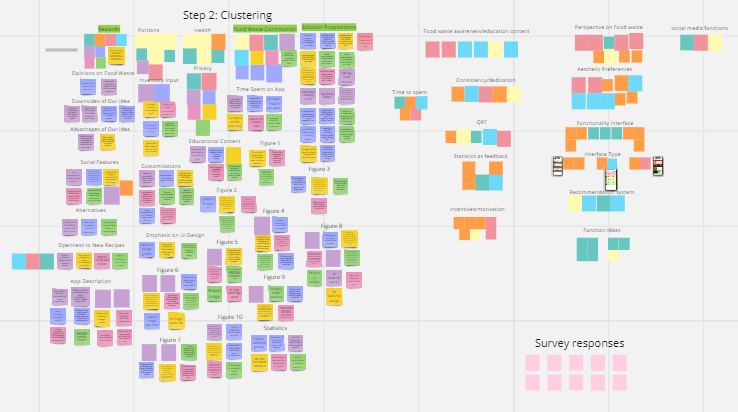

User Requirements
Must have
- Virtual Inventory: The users can store their product inventories in the app.
- Textual input: The users can input their bought products into the app by writing down their names, quantities, and expiration dates.
- Notifications: The app informs the user when a product in the inventory is about to expire.
- Recipe suggestions & filtering: The app suggests recipes based on the ingredients available in the user’s inventory. The recipes can be filtered by cuisines, cooking time, calorie count, and available cooking utensils.
- Storage of User Information (relevant to recipe filtering): The users can input their allergies, chronic diseases, cultural/religious food limitations, and diets, which are stored in the user profile and then accounted for when recommending recipes.
- Anonymous Login: The users can log in to the app anonymously to maintain their privacy.
Should have
- Adjustable portion size: Users can adjust the portion size depending on the number of people in the household.
- Info tab: General information about food waste, could also include tips on how to store various groceries, such as fruit and vegetables and generally on cooking sustainably. This should be at the back of the app, accessible but not too annoying
- Scanning Data Input: QR scanning for inputting bought items into the virtual inventory.
- Expiry Date Prediction: The app predicts the approximate expiry date of certain products that do not have a specific expiry date, also based upon where it is stored (fridge, freezer or shelf).
- Saving Liked Recipes: The app has a “favorite” page where users’ favorite recipes are stored.
- Ingredient Substitutes: Have the possibility to substitute ingredients in the recipes with analogous products.
Could have
- Rewards: Continuous use of the app can gain the user some sort of virtual points, which can be used to acquire discounts at big retailers or even full-on food packages.
- Calorie Tracking: Users of the app can select the number of calories that they want to eat of their chosen meals, and the app consequently recommends ingredient quantities.
- Statistics: The app includes personalized information on how well the user is utilizing the app, like streaks of daily use and perhaps comparisons to other users.
- Tutorial: When a new user joins the app, there is a short, optional tutorial that teaches the user how to properly use the app.
- Integrated shopping list: The user can add ingredients that are required for a specific recipe to the shopping list. Also, when a product runs out it gets added to the shopping list automatically.
- Social Features: Users can contact each other and form communities where they can share information and interact.
Won’t have
- Filling per calorie: List meals based upon how much they fill
- Food Freshness: An additional indicator based on predictions, next to whether the food is within the expiry date and whether one indicating food is still fresh (nice to eat).
- Health Statistics: Month overview of food eating patterns and health wise comparison to yourself
- Custom recipes: The user can add their custom recipes to the app, with option to share it with others
General Findings
- People don't think they need assistance because they don't waste a lot, which however they do.
- The design should be minimalistic and intuitive, prioritizing functionality.
- Virtual Fridge: mix different elements from the 3 fridges: From 1st fridge, have it look like an actual fridge, use PNG images. 2nd fridge: color coding and expiry date. 3rd fridge: group by expiry date, high quality pictures
- People want bright aesthetics, food is a happy thing
App

⠀
Sign up and Login
Actions
This part of the app is meant for account creation. Thus you can sign up, sign in, sign in anonymously, and sign out. For signing up an email, username and password is required. Signing in anonymously does not require anything. Signing out can be done through the profile fragment, upon opening the 3 dots menu.
Decisions
The option for anonymous sign in had been added, as that was desired from the participants of the initial app survey. The requirement of a username is done, in order to display it on the profile page. That username can be used to address the user.
Inventory Fragment
Actions
Decisions
Recipe Fragment
Actions
Decisions
Favorites Fragment
Actions
Decisions
Alerts Fragment
Actions
Decisions
Profile Fragment
Actions
Decisions
API
Decisions
Recommendation algorithms/techniques
Steps to take before we can filter and sort the recommendations:
There are a few steps that have to be taken before the actual prioritization of the left over recommendations:
- Before we even send a call to the api we have to define some ingredients we can assume that people will have in their homes. These are things like oil, salt, pepper etc.
- When this is done, we will send a call where the available ingredients are the default ones + the ingredients in the fridge. From this, we get an return that has different recipes with a list of ingredients needed for those recipes.
Possible options:
The best option for our use case is probable to use a content-based filtering algorithm. This is a method where you just compare the contents of the recipes with the contents of the fridge, and give a score to each item in the fridge. Then for all items in the recipes that are items in the fridge the scores are added together and the recipes with the highest scores are displayed first.
Score calculation:
With the calculation of the scores we can take into account that we want to prioritize items that are close to or just over the expiration date. We can do this by mapping an exponential function to the score, where it gets higher when the item is closer to the maximum expiration date. This date is something we can set based on the category of the item, and the expiration date the user would putt in. So for example, for some kind of vegetable this could be expiration date + 5 days. Ofcourse, when an item is over the expiration date given by the manufacturer, there will be a warning to check the food well before use. Also, to make sure that no recipes get recommended with items that are over the maxiumum date, we can set the score of those items to a large negative number, making sure that the score of that total recipe will be very low thus not making it on the list.
Possible upgrades that probably are out of scope for this project:
In the future, when the app would have a substantial use case it would be possible to switch to another hybrid recommendation system. In this system there would be a collaborative filtering aspect to it. This would give the user a more tailored experience, while also discovering more new recipes. This is only possible with a large user base because the collaborative filtering system recommends recipes that other similar users have made. For this, the app would build a profile of the user where it looks at what kind of recipes the user cooks, and look at similar other users for some recipes that the user has a high probability of also liking. Because the main focus of this application is to reduce food waste we will go with the content-based filtering and focus on the scoring calculation.
Design iterations


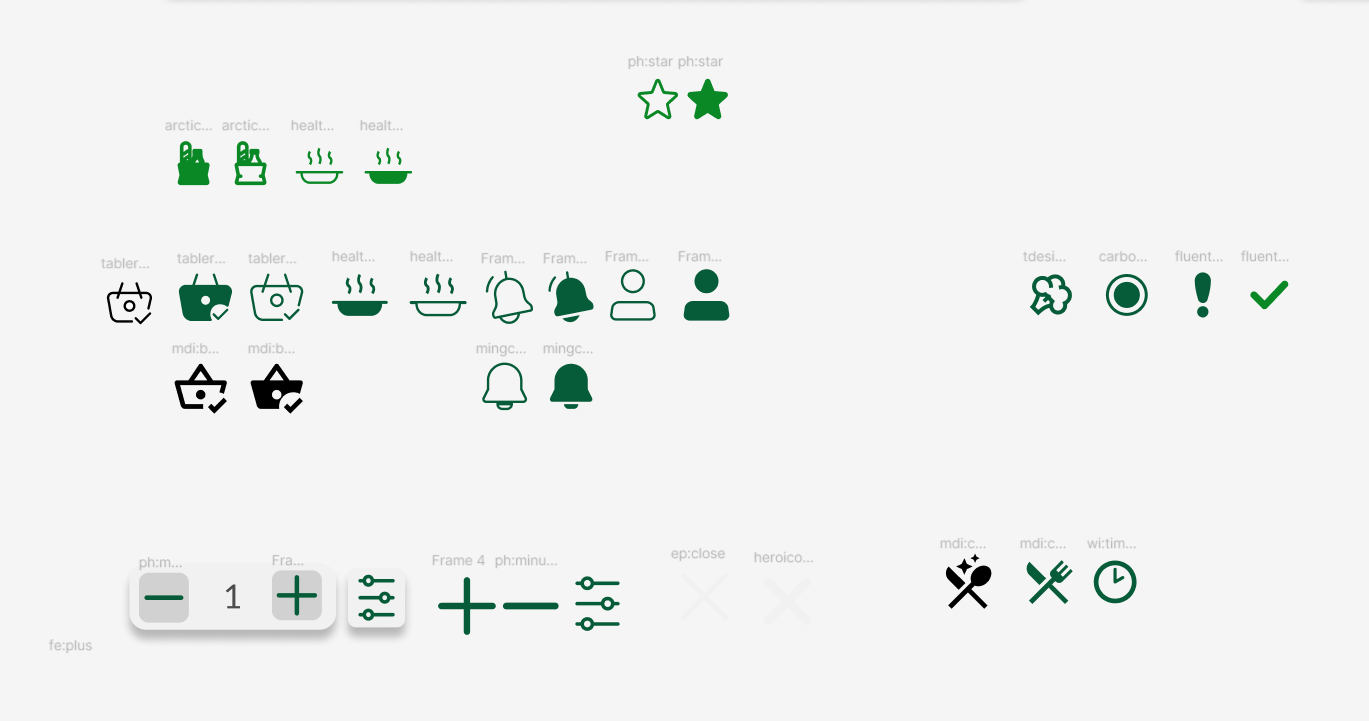

Appendix
Survey questions
Link to Google Forms: https://forms.gle/2RRD5r4F2SRnbFrW9
Survey questions:
1. Please indicate your age:
- Below 18
- 18-24
- 25-34
- 35-44
- 45-54
- 55-64
- Above 65
For the first part of the survey, please choose the options that best reflect your experience.
(On a scale from 1 to 5, with 1 and 5 being "Strongly disagree" and "Strongly agree", respectively.)
2. I frequently throw away food.
3. I throw away a large amount of food.
4. I often forget about the food in my fridge.
5. I cook more than I can eat.
6. I don’t reuse leftovers.
7. I don’t cook / don’t want to cook because I (multiple options possible):
- Don’t have enough time
- Don’t know what to cook
- Don’t cook well
- Not applicable
- Other:
8. I am aware of the problem of food waste.
9. I am willing to reduce the amount of food waste I produce.
To combat food waste at a consumer level, we are making a mobile application that keeps track of ingredients available at home and suggests recipes based on that.
10. Would you consider using such an app?
- Yes
- No
- Maybe
For the next three questions, please choose designs that are most appealing to you (multiple options possible).
11. Overall look:
- Option 1
- Option 2
- Option 3
- Option 4
- Option 5
- Option 6
12. Login page:
- Option 1
- Option 2
- Option 3
- Option 4
13. Display of food items:
- Option 1
- Option 2
- Option 3
14. What would be the most convenient way to add food items to the inventory (multiple options possible)?
- Via text input
- Via voice input
- Via scanning a barcode
- Via taking a picture of the product
- Other:
15. What additional features would you like to see in an app (multiple options possible)?
- Notify when the product is about to expire
- Have an integrated shopping list
- Add expiration date to the list automatically
- Filter recipes (by preparation time, cuisine, etc.)
- Inform the user about food waste
- Other:
16. If you have any additional comments / suggestions please leave them below:
Preliminary literature study (week 1)
Food waste matters - A systematic review of household food waste practices and their policy implications[7]
In recent years concerns regarding food waste have increased due to its environmental impact . Resource depletion and greenhouse gas emissions that food waste causes are a important reason for this. "Globally, nearly one third of food produced for human consumption is lost or wasted, equalling a total of 1.3. billion tonnes of food per year”. Food waste is also indirectly accompanied by other environmental impacts like: soil erosion, deforestation, water and air pollution as well as green house emmisions which occur during the food production process, also thik of transportation. In the food supply chain, households represent the largest food waste section. In summary, if food is wasted in households, all energy was in vain and the complementary environmental impacts are for nothing. A holistic food waste prevention has to go beyond putting the responsibility solely on the consumers, policy makers need to be commited as well. Food waste prevention has to become the more attractive option for households.
Learning from and designing after pandemics. CEASE: A design thinking approach to maintaining food consumer behaviour and achieving zero waste[13]
According to this article, a CEASE (Community, Engagement, Actions, Sharability and Ecosystem) approach to the food waste problem would be beneficial. What this means is that the design to combat food waste should be: 1) Community based, it should emphasize with the user. This focuses on the emotional and social desires of a community, the goal is to highlight the value that are basis for emerging behaviour patterns. Secondly, Engagement, interacting with the users is important and they need a sense of empowerment. Thirdly, actions, this is the part where you ideate for solutions and come up with potential prototype. Shareability is about creating a prototype that can be shared. Lastly Eco-systems are tested in to predict long term results and possible problems.
Food Waste Prevention: a design intervention for Households[14]
This is the report of an Industrial Design student from Delft who did a design project about food waste prevention in households. The article discovers the main traits of the wasters. For example, young adults mainly waste food because of their busy lifestyle while large households (4+ members) generally waste the most due to less consciousness in reusing leftovers into new meals. It also takes a look at already existing initiatives like: Eetmaatje, the fridge and freezer sticker, slim koken app, de verspillingsvrijeweek, and educational initiatives in general.
The final design were the “Eetkaartjes”, a design that aimed to make leftovers more apperent, force a sense of responsibility on the user and have the fridge more organised.
Design an Intervention to Support Food Waste Prevention at Home[15]
Another Design graduation project was that of by Fauza Karomatul Masyhuroh, also from the TU Delft. From user research, it was concluded that “In the current practice, people already display food. However, sometimes this makes the kitchen a bit messy, and some food is still discarded due to getting rotten. So they expect the food in a neat and pretty way and ease them organising older and newer food to prevent spillage.
The final design that was created was Foodi, a storage system for fruits and partly vegetables. To slow down the riping process, different fruits were seperated to contain their Ethylene gasses.
Food Waste at Consumer Level[4]
This source explores food waste at consumer level in depth. It tries to understand the consumer behaviour that causes food waste. The general conclusion this paper made was that . It concluded that household food waste depends on consumer food management which means: “planning, provisioning, storing, preparing, consuming, disposal, and the consumer decision process: planning, pre-acquisition, acquisition, preparation, consumption, disposition.”
Food Waste Management: Solving the Wicked Problem[16]
This article gives an research-based overview of food-waste by looking at environmental, socia-economic, economic, social and ethical considerations. In the 4th part it also looks at practical innovative solutions like for example insect-based bioconversion or Gleaning. The first one being about how insects could consume waste while producing valuable resources. Gleaning however is a very old technique used to salvage crops from farms which would otherwise rot. It also looks at assumptions made about consumers and how they relate to campaigns against food waste. Additionally, the book explored food waste reducing apps.
Over Orbisk[17]
Orbisk is a start-up company that aims to make the global food system more sustainable. They want to use emerging technologies like Computer Vision and AI to automatically monitor all food that is thrown away on ingredient level. The sensors used would be a camera above the trash bin. These insights can then be used by for example restaurants to adjust their menu.
Healthy cooking behavior monitoring devices[18]
This article is about a study regarding at home cooking practices using the healthy cooking index. This could be relevant to Foodini since optimizing nutrition values is also an important aspect of food. This article user tested the effectiveness of using devices that could asses (healthy) cooking behaviour and it concluded that these tools have the potential to enhance cooking education, disease prevention and health outcomes.
Understanding Food Loss and Waste—Why are we losing and wasting food?[1]
Definitions of food loss and food waste, quantification, causes of food loss and waste at different stages of the food supply chain.
Key points:
- Four main criteria affect food waste during the consumption stage: household size and composition, income, culture, and demographic factors;
- In addition to these four main factors, it has been widely confirmed in the literature that the individual attitudinal factor could also influence the FLW reduction.
A systematic literature review on food waste/loss prevention and minimization methods[19]
- 1/3 of the edible parts of food produced for human consumption worldwide is either wasted or lost
- food loss and prevention methods can be an effective alternative for substantially reducing food waste through
- food waste policies
- programs
- campaigns
- changes in human behavior
A systems approach to assessing environmental and economic effects of food loss and waste interventions in the United States[20]
Digital platforms: mapping the territory of new technologies to fight food waste[21]
This article presents a comprehensive list of digital platforms for food waste management.
Using artificial intelligence to tackle food waste and enhance the circular economy: Maximising resource Efficiency and Minimising Environmental Impact: A review[22]
The role of AI in preventing food waste, more specifically in smart monitoring, predictive analytics, smart inventory management, consumer awareness and education, donation and redistribution.
Food Waste Management: AI Driven Food Waste Technologies[23]
This article is about how AI driven technologies can be utilized to combat food waste. It describes that current strategies exist out off combating food waste mainly in the supply chain and however these have their limitation. The article discusses how AI can be used to optimize supply chain management, predict demand and could reduce food spillage. Food Cowboy and Winnow are an example, they help commercial kitchens distribute the surplus of food and hereby prevent spillage. It also talks about the ethical and societal consequences AI in food waste combat could potentially have.
Smart strategies for household food waste management[24]
The article presents an integrated system that aims at reducing household food waste. The system consists of a cloud database, a smart fridge, and a web application. The web application allows the user to interact with the smart system. The 4 main app features are:
- Ingredients management: Tracks food in the fridge, freezer, and pantry, the left quantity, and the date of purchase, opening, and/or expiration. Suggests actions depending on the expiry date on a daily basis. Adds depleted items to the shopping list.
- Proper food placement guiding: Leads the user in placing the products in the right fridge compartment to guarantee better storage conditions and increase the shelf life.
- Shopping list management: Remembers the products available at home. Also notifies the user of promotional items and adds them to the list of suggested products.
- Smart recipes suggestion: Suggests recipes by checking, filtering, and ordering ingredients available at home and closest to their expiration date.
Determinants of Food Waste from Household Food Consumption: A Case Study from Field Survey in Germany[8]
A study conducted in Germany revealed that households in high-income countries contribute significantly to food loss and waste. On average, per capita food waste stands at 59.6 kg annually, with 49% of it being avoidable. Fruits and vegetables are the most wasted food items as per the compiled estimated composition of food waste. The study identified many reasons for food disposal, with 38% of the respondents citing lack of time to process food as the primary driving force. The second most common reason was that people cook more food than required, leading to leftovers being disposed of.
Household food waste: Attitudes, barriers and motivations[25]
This study delves into people's attitudes towards food waste, examining the obstacles that hinder efforts to reduce it and the underlying factors that cause wastage. The key findings reveal that "Lack of environmental awareness" and "Exemption from responsibility" due to bulk and near-to-expiry sales are major contributors. Furthermore, it has been observed that guilt is a powerful tool in curbing food waste, as it encourages individuals to provide only the necessary amount of food for themselves or their loved ones.
To address these issues, several recommendations have been made. These include educational campaigns in collaboration with educational institutions and workplaces to inform the public about the environmental and socio-economic impacts of food waste. Additionally, practical measures such as providing free waste sorting bins to households, implementing financial incentives or penalties like the "Pay-As-You-Throw" system, and strengthening legal and regulatory frameworks are suggested. These approaches have been proven effective in various countries.
Preventing wasted food at home[26]
benefits of saving food:
- save money by buying only what you actually need and consume
- reduce environmental and climate footprint
- wasted food = wasted services like: transport, processing, preparing, storing etc.
ways to prevent food waste:
- Keep list of meals and their ingredients that your household already enjoys → shop for meals that are most likely to be consumed
- Look in your refrigerator to avoid buying food you already have
- Make a list each week of what needs to be used up and plan upcoming meals around it.
- Plan your meals for the week before you go shopping and buy only the things needed for those meals.
- Take into consideration how many days you will eat out vs eat at home and think about eating leftovers before you shop
- Include quantities on your shopping list noting how many meals you’ll make with each item to avoid overbuying. For example: “salad greens - enough for two lunches”
- Buying in large quantities (e.g., buy one get one free deals/discount deals) only saves money if you use all the food before it spoils
- Purchase imperfect produce or upcycled products. Imperfect produce may have physical imperfections but is just as safe and nutritious and can sometimes be found at discounted prices. Upcycled products are made from ingredients that might have otherwise gone to waste
Storage tips
- Properly store fruits and vegetables for maximum freshness
- Most veggies should go in the high humidity drawer of the fridge
- Most fruits should go in the low humidity drawer of the fridge
- Some fruits (such as bananas, apples, pears, stone fruits, and avocados) release ethylene gas as they ripen, making other nearby produce ripen, and potentially spoil, faster. Store these away from other vegetables and fruits.
- Some vegetables, such as potatoes, eggplant, winter squash, onions, and garlic, should be stored in a cool, dry, dark, and well-ventilated place
- Make sure you are properly storing food in your refrigerator.
- refrigerator door is the warmest part of the fridge → store condiments there, but it is not recommended to store milk or eggs in the door
- The lower shelves are the coldest part of the fridge. Store meat, poultry, and fish here.
- Store grains in airtight containers and label containers with contents and the dates.
- Befriend your freezer and visit it often. Freeze food such as bread, sliced fruit, meat, or leftovers that you know won’t be eaten in time. Label with the contents and dates.
Cooking and preparation tips
- Produce that is past its prime, as well as odds and ends of ingredients and leftovers, may still be fine for cooking. Repurpose these ingredients in soups, casseroles, stir fries, frittatas, sauces, baked goods, pancakes, or smoothies
- Learn the difference between “sell-by,” “use-by,” “best-by,” and expiration dates.
Household Food Waste: The Meaning of Product’s Attributes and Food-Related Lifestyle[27]
product attributes that contribute to waste:
- meat, seafood, fruits and vegetables are wasted the most because they are fresh products
- visually non appealing foods are wasted a lot, e.g, imperfect fruit
consumer related determinants of food waste include
- time for food related activities
- cooking skills
- knowledge and awareness
households' inability to estimate their own consumption is a major contributor to food waste
3 consumer clusters were found in the study
- consumers who are against wasting products with favorable taste or healthy products → mostly women and people with the highest income
- consumers who are against wasting food that is convenient/easy to prepare → mostly students
- consumers who have no food wasting morale and who are thus the most wasteful → mostly people with full time jobs
Planning & Timesheet
Planning
Research team
- Sem
- Aydan
- Vlad
Development team
- Manka
- Yi Hang
- Bohao Ye
Underlined = deliverables
Week 1
Research
- Choose a subject - Everyone
- Research the problem - Everyone
- Find 25 articles and summarize (partly for now) – Sem, Aydan, Bohao
Development
- Implement sign up and sign in – Yi Hang
Week 2
Development
- Complete mock-up user interface designs ½ - Manka, Sem
- Start Page
- Login
- Sign up
Research
- Investigate state-of-the-art apps, add to wiki ½ – Aydan, Vlad
- Survey questions - Aydan
- App requirements (MoSCoW) - Bohao
Week 3 – Complete the survey
Development
- Complete mock-up user interface designs 2/2 - by Wednesday – Manka, Sem
- Inventory page
- Recipe page
- XML for login, sign up and inventory – Manka
- App Logo - Manka
- Implement Inventory – Yi Hang
- Page for item entry
- Enter expiration date
Research
- Investigate state-of-the-art apps, add to wiki 2/2 - Aydan, Vlad
- Summary of survey, add to wiki - Aydan
Week 4
Development
- XML for recipe page – Manka
- Implement Recipe page – Bohao, Yi Hang
- Notifications – Bohao
Research
- Put together contents for info page – Aydan, Vlad
Week 5 – First working version
Development
- Notifications – Bohao
- Information page – Manka
Week 6
Research
- Conduct user test – Everyone + 3rd party
- Collect and analyze user test results - Everyone
Week 7 – Final version
Development
- Add fixes to app according to user feedback – Development team
Week 8
- Create final presentation - Everyone
- Peer review - Everyone
Timesheet
Week 1
| Time (H) | Summary | Notes | |
|---|---|---|---|
| Yi Hang | 11:45 | Meetings, implement sign up and login | |
| Manka | 08:50 | Meetings, work on UI designs, research, summaries, wiki edits | |
| Aydan | 16:10 | Meetings, research, summaries, editing wiki | |
| Bohao | 11:40 | Meetings, research, summaries | |
| Sem | 9:55 | Meetings, research, summaries | |
| Vlad | 7:10 | Meetings, research |
Week 2
| Time (H) | Summary | Notes | |
|---|---|---|---|
| Yi Hang | 13:18 | Meetings, and programming | |
| Manka | 14:35 | Meetings, Design, Frontend programming | |
| Aydan | 11:10 | Survey questions, state-of-the-art apps research and testing, editing wiki | |
| Bohao | 12:20 | Meeting, Research, Recommendation Class structure Design, Planning of Recommendation Algorithm | |
| Sem | 10:15 | Meetings, Aesthetic Literature Research, Interface Design Photoshop, Aesthetic Related Interview Questions, Reading/Writing | |
| Vlad |
Week 3
| Time (H) | Summary | Notes | |
|---|---|---|---|
| Yi Hang | 16:10 | Programming | |
| Manka | 16:37 | Design polishing, frontend programming (adding new features to the UI) | |
| Aydan | 08:00 | Data analysis, editing wiki, writing | |
| Bohao | |||
| Sem | |||
| Vlad | |||
| Jip |
Week 4
| Time (H) | Summary | Notes | |
|---|---|---|---|
| Yi Hang | |||
| Manka | 20:25 | Color days till expiration, savestate of fragments, onbackpressed behavior, recipe page, profile page, full deisgn update | |
| Aydan | 04:45 | Literature review, food waste facts for the info tab, survey analysis | |
| Bohao | |||
| Sem | |||
| Vlad |
Week 5
| Time (H) | Summary | Notes | |
|---|---|---|---|
| Yi Hang | |||
| Manka | 23:00 | Recipe show page, bottom navigation for both gesture and soft key navigation, info page, small fixes | |
| Aydan | 08:35 | Meetings, affinity diagramming, literature review, editing wiki | |
| Bohao | |||
| Sem | |||
| Vlad |
Week 6
| Time (H) | Summary | Notes | |
|---|---|---|---|
| Yi Hang | |||
| Manka | 12:50 | Advanced fiters and intolerances design + implementation | |
| Aydan | |||
| Bohao | |||
| Sem | |||
| Vlad |
Week 7
| Time (H) | Summary | Notes | |
|---|---|---|---|
| Yi Hang | |||
| Manka | |||
| Aydan | |||
| Bohao | |||
| Sem | |||
| Vlad |
Week 8
| Time (H) | Summary | Notes | |
|---|---|---|---|
| Yi Hang | |||
| Manka | |||
| Aydan | |||
| Bohao | |||
| Sem | |||
| Vlad |
Total
| Time (H) | |
|---|---|
| Yi Hang | |
| Manka | |
| Aydan | |
| Bohao | |
| Sem | |
| Vlad |
References
- ↑ 1.00 1.01 1.02 1.03 1.04 1.05 1.06 1.07 1.08 1.09 1.10 1.11 1.12 1.13 1.14 1.15 Ishangulyyev, R., Kim, S., & Lee, S. (2019). Understanding food loss and waste—Why are we losing and wasting food? Foods, 8(8), 297. https://doi.org/10.3390/foods8080297
- ↑ 2.0 2.1 2.2 2.3 Food waste in the united states. (n.d.). Ballard Brief. Retrieved February 17, 2024, from https://ballardbrief.byu.edu/issue-briefs/food-waste-in-the-united-states
- ↑ (N.d.). Retrieved February 17, 2024, from https://food.ec/safety/food-waste_en
- ↑ 4.0 4.1 4.2 4.3 4.4 4.5 4.6 4.7 Principato, L. (2018). Food waste at consumer level. Springer International Publishing. https://doi.org/10.1007/978-3-319-78887-6
- ↑ The difference between food loss and food waste. (n.d.). PostHarvest Technologies. Retrieved April 5, 2024, from https://www.postharvest.com/blog/the-difference-between-food-loss-and-food-waste
- ↑ Food waste definition. (n.d.). Retrieved April 5, 2024, from https://www.eu-fusions.org/index.php/about-food-waste/280-food-waste-definition
- ↑ 7.00 7.01 7.02 7.03 7.04 7.05 7.06 7.07 7.08 7.09 7.10 7.11 7.12 7.13 7.14 7.15 7.16 Schanes, K., Dobernig, K., & Gözet, B. (2018). Food waste matters—A systematic review of household food waste practices and their policy implications. Journal of Cleaner Production, 182, 978–991. https://doi.org/10.1016/j.jclepro.2018.02.030
- ↑ 8.0 8.1 Hermanussen, H., Loy, J.-P., & Egamberdiev, B. (2022). Determinants of food waste from household food consumption: A case study from field survey in germany. International Journal of Environmental Research and Public Health, 19(21), 14253. https://doi.org/10.3390/ijerph192114253
- ↑ 9.0 9.1 9.2 9.3 Ajzen, I., & Schmidt, P. (2020). Changing behavior using the theory of planned behavior. In M. S. Hagger, L. D. Cameron, K. Hamilton, N. Hankonen, & T. Lintunen (Eds.), The Handbook of Behavior Change (1st ed., pp. 17–31). Cambridge University Press. https://doi.org/10.1017/9781108677318.002
- ↑ Behavioral change models. (n.d.). Retrieved April 5, 2024, from https://sphweb.bumc.bu.edu/otlt/MPH-Modules/SB/BehavioralChangeTheories/BehavioralChangeTheories_print.html
- ↑ Srivast, S. K., Mishra, A., Singh, S., & Jaiswal, D. (2022). Household food waste and theory of planned behavior: A systematic review and meta-analysis [Preprint]. In Review. https://doi.org/10.21203/rs.3.rs-1906539/v1
- ↑ Ali, M., Ullah, S., Ahmad, M. S., Cheok, M. Y., & Alenezi, H. (2022). Assessing the impact of green consumption behavior and green purchase intention among millennials toward sustainable environment. Environmental Science and Pollution Research, 30(9), 23335–23347. https://doi.org/10.1007/s11356-022-23811-1
- ↑ Massari, S., Principato, L., Antonelli, M., & Pratesi, C. A. (2022). Learning from and designing after pandemics. CEASE: A design thinking approach to maintaining food consumer behaviour and achieving zero waste. Socio-Economic Planning Sciences, 82, 101143. https://doi.org/10.1016/j.seps.2021.101143
- ↑ Dott, J. (2020). Food waste prevention: A design intervention for households. https://repository.tudelft.nl/islandora/object/uuid%3A9f7cceaf-9942-4fa4-aadf-7109d53f51e8
- ↑ Fauza Karomatul Masyhuroh, F. (2021). Design an intervention to support food waste prevention at home. https://repository.tudelft.nl/islandora/object/uuid%3A20e9fe37-3853-4366-ae9f-37e6e3d0c3ec
- ↑ Närvänen, E., Mesiranta, N., Mattila, M., & Heikkinen, A. (Eds.). (2020). Food waste management: Solving the wicked problem. Springer International Publishing. https://doi.org/10.1007/978-3-030-20561-4
- ↑ Over Orbisk—Op een missie om het wereldvoedselsysteem duurzamer te maken. (n.d.). Orbisk. Retrieved February 17, 2024, from https://orbisk.com/nl/over-orbisk/
- ↑ Raber, M., Baranowski, T., Crawford, K., Sharma, S. V., Schick, V., Markham, C., Jia, W., Sun, M., Steinman, E., & Chandra, J. (2020). The healthy cooking index: Nutrition optimizing home food preparation practices across multiple data collection methods. Journal of the Academy of Nutrition and Dietetics, 120(7), 1119–1132. https://doi.org/10.1016/j.jand.2020.01.008
- ↑ Moraes, N. V., Lermen, F. H., & Echeveste, M. E. S. (2021). A systematic literature review on food waste/loss prevention and minimization methods. Journal of Environmental Management, 286, 112268. https://doi.org/10.1016/j.jenvman.2021.112268
- ↑ Muth, M. K., Birney, C., Cuéllar, A., Finn, S. M., Freeman, M., Galloway, J. N., Gee, I., Gephart, J., Jones, K., Low, L., Meyer, E., Read, Q., Smith, T., Weitz, K., & Zoubek, S. (2019). A systems approach to assessing environmental and economic effects of food loss and waste interventions in the United States. Science of The Total Environment, 685, 1240–1254. https://doi.org/10.1016/j.scitotenv.2019.06.230
- ↑ Cane, M., & Parra, C. (2020). Digital platforms: Mapping the territory of new technologies to fight food waste. British Food Journal, 122(5), 1647–1669. https://doi.org/10.1108/BFJ-06-2019-0391
- ↑ Onyeaka, H., Tamasiga, P., Nwauzoma, U. M., Miri, T., Juliet, U. C., Nwaiwu, O., & Akinsemolu, A. A. (2023). Using artificial intelligence to tackle food waste and enhance the circular economy: Maximising resource efficiency and minimising environmental impact: a review. Sustainability, 15(13), 10482. https://doi.org/10.3390/su151310482
- ↑ Singh, S. (2023, January 16). Food waste management: Ai driven food waste technologies. Analytics Vidhya. https://www.analyticsvidhya.com/blog/2023/01/food-waste-management-ai-driven-food-waste-technologies/
- ↑ Cappelletti, F., Papetti, A., Rossi, M., & Germani, M. (2022). Smart strategies for household food waste management. Procedia Computer Science, 200, 887–895. https://doi.org/10.1016/j.procs.2022.01.286
- ↑ Nunkoo, R., Bhadain, M., & Baboo, S. (2021). Household food waste: Attitudes, barriers and motivations. British Food Journal, 123(6), 2016–2035. https://doi.org/10.1108/BFJ-03-2020-0195
- ↑ US EPA, O. (2013, April 18). Preventing wasted food at home [Overviews and Factsheets]. https://www.epa.gov/recycle/preventing-wasted-food-home
- ↑ Szymkowiak, A., Borusiak, B., Pierański, B., Kotyza, P., & Smutka, L. (2022). Household food waste: The meaning of product’s attributes and food-related lifestyle. Frontiers in Environmental Science, 10, 918485. https://doi.org/10.3389/fenvs.2022.918485
